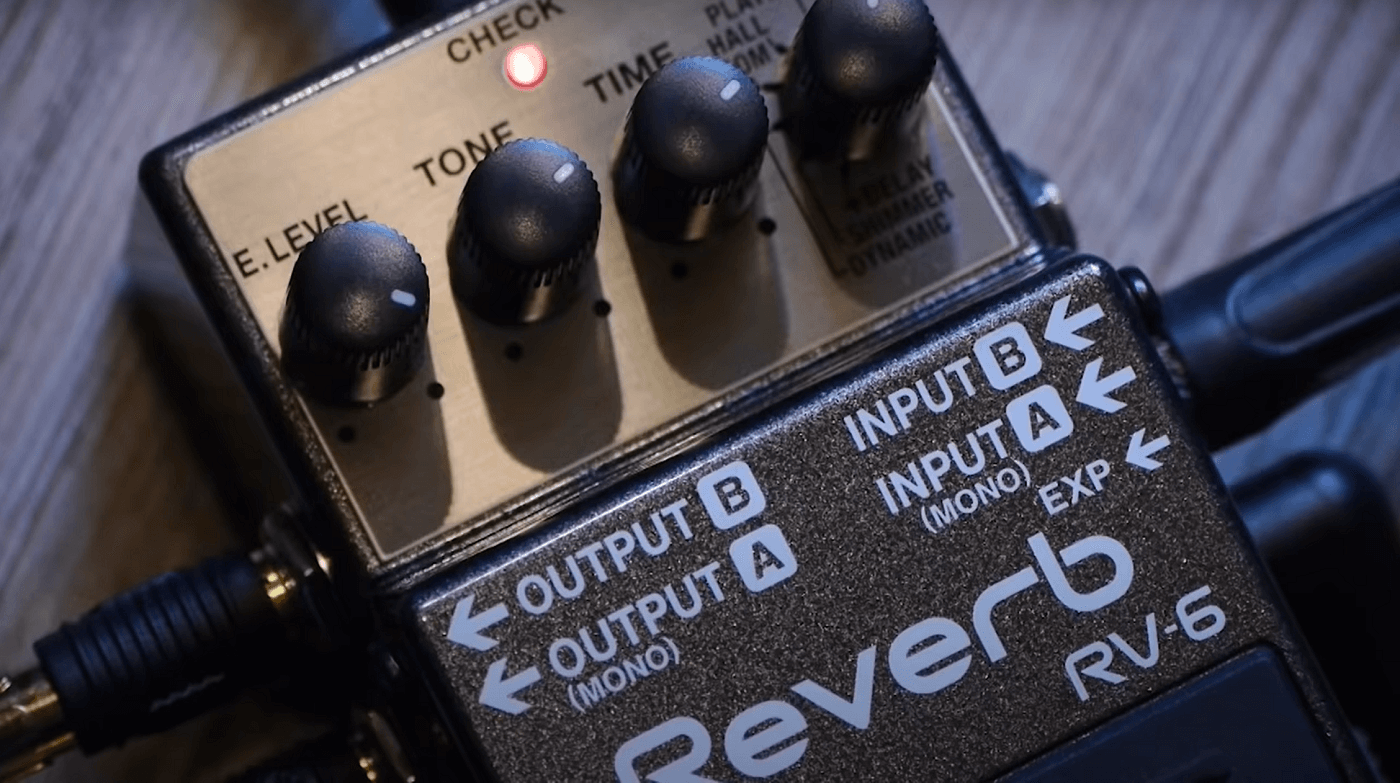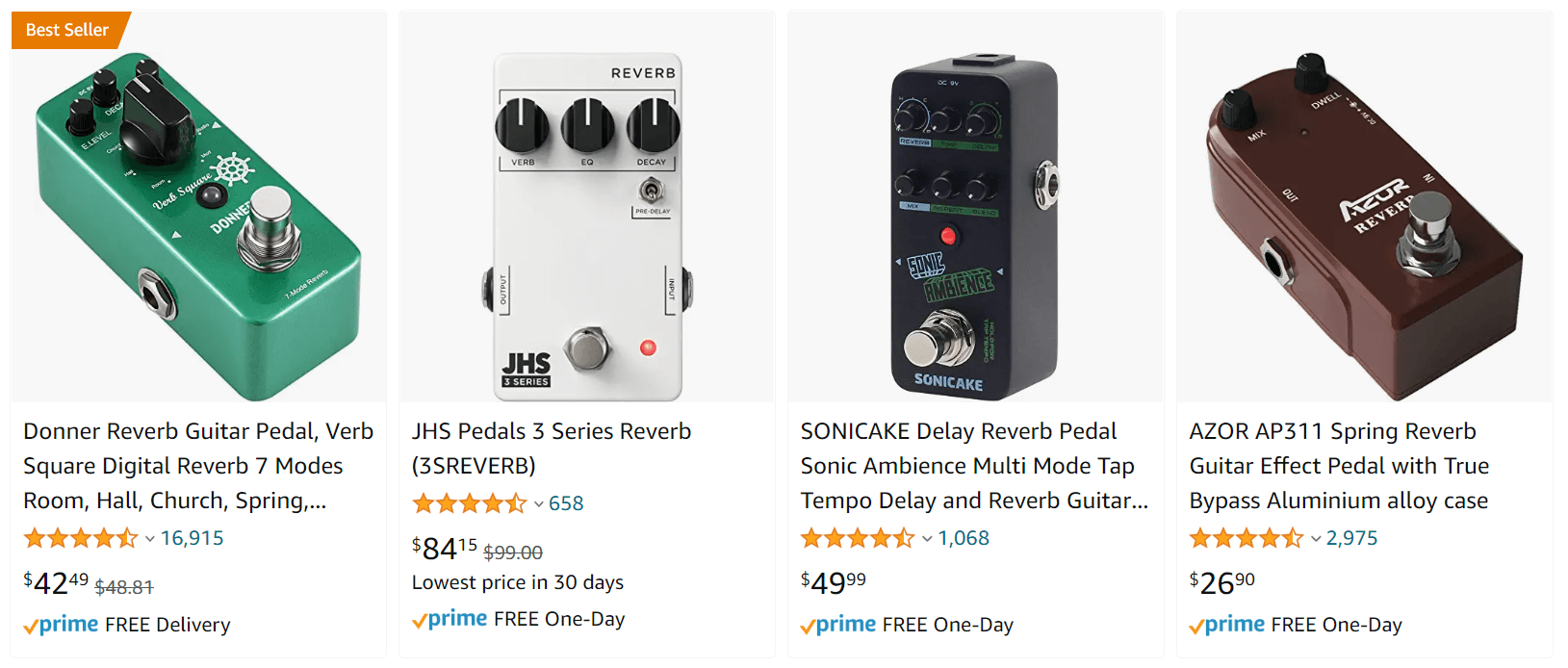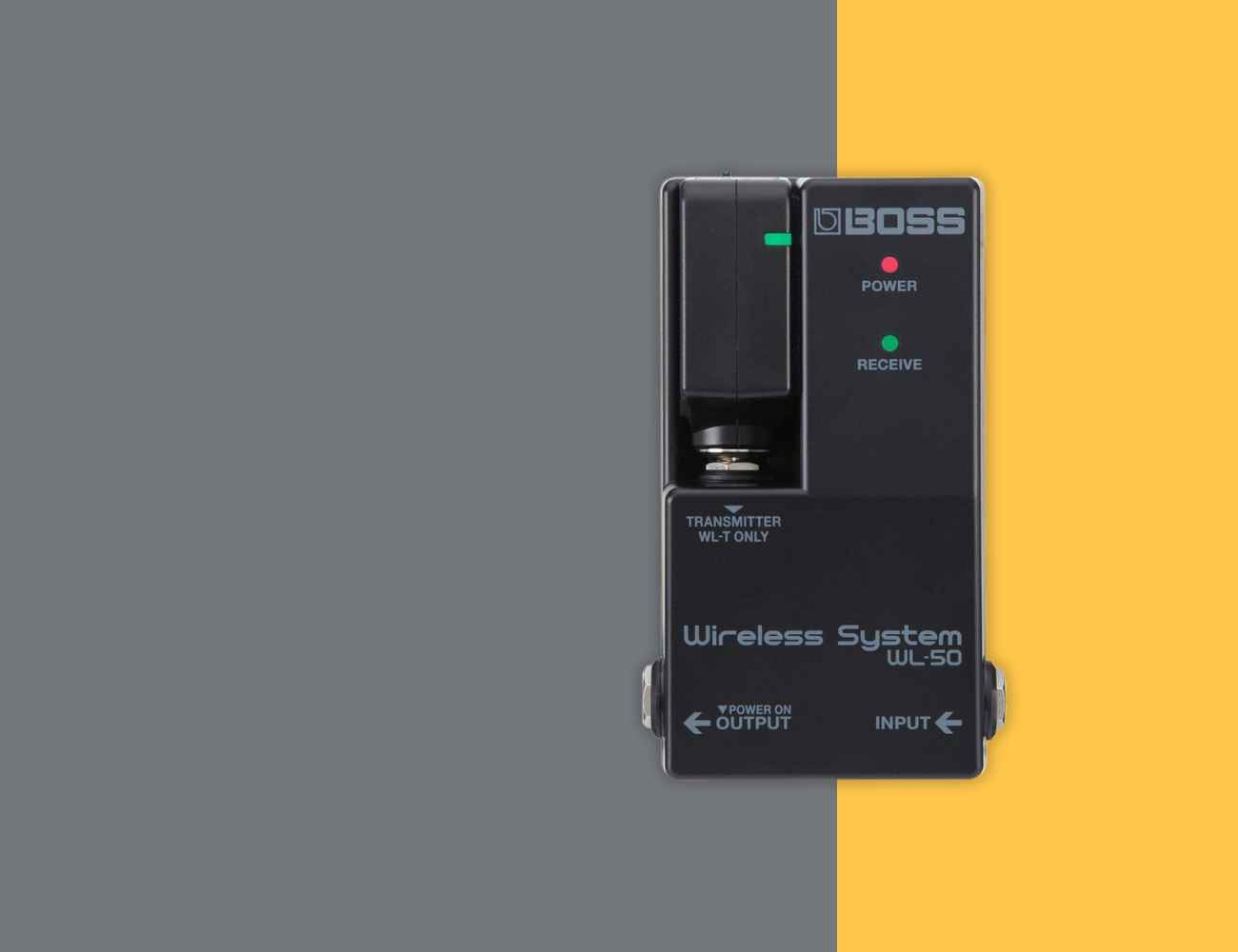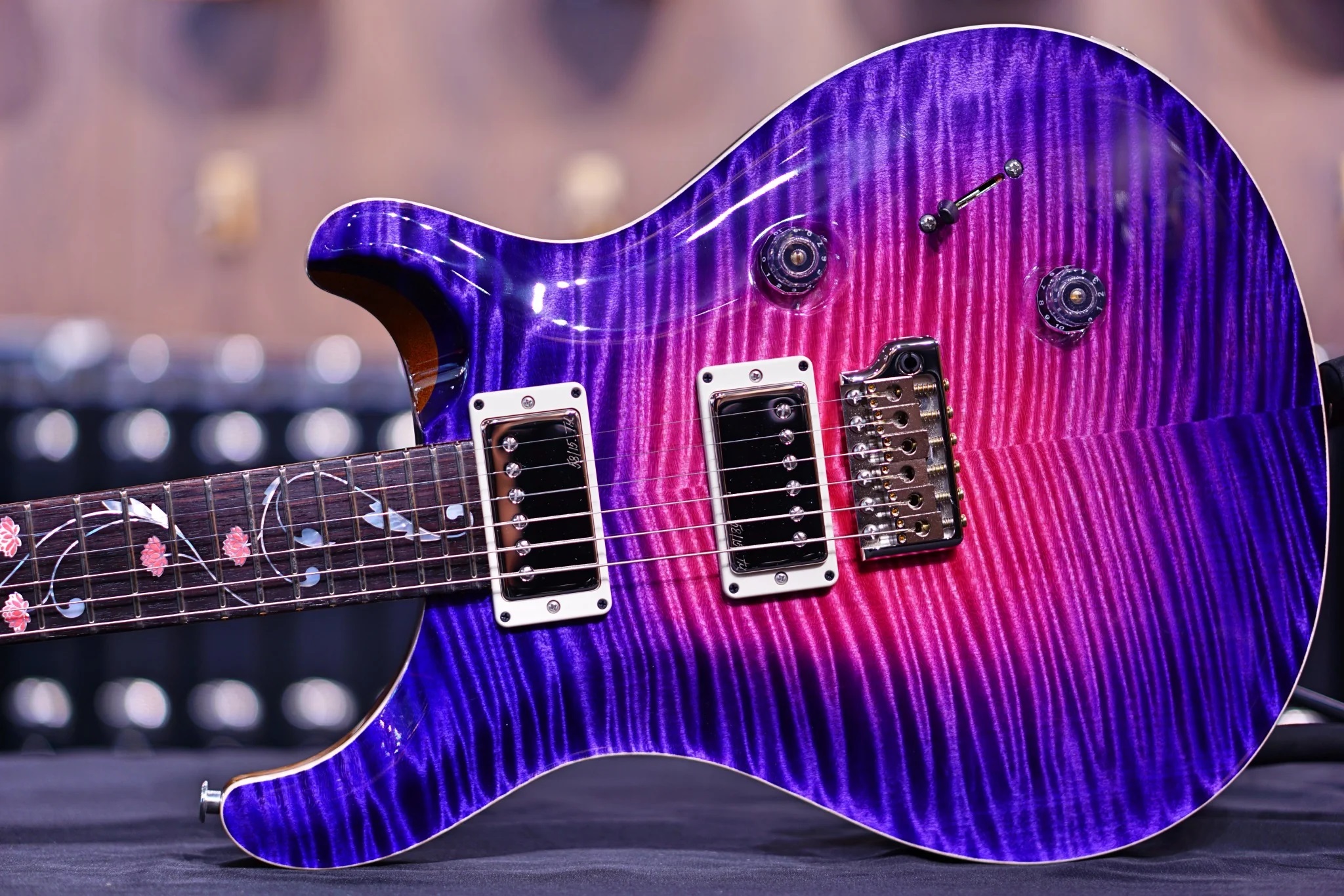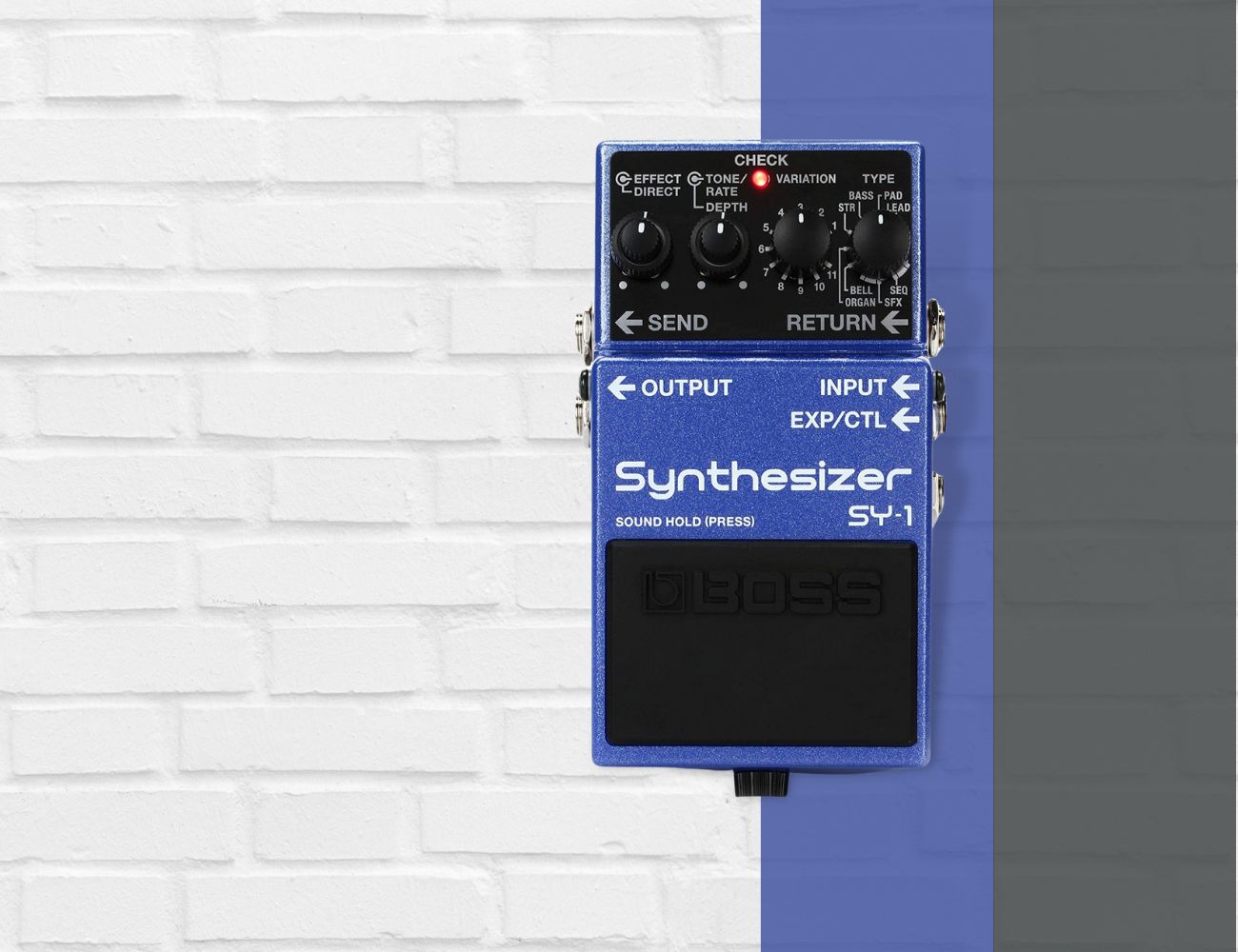Imagine transforming your guitar’s sound from ordinary to extraordinary with the simple press of a pedal.
That’s the power of a good reverb pedal that’s versatile and full of feature.
These magical devices can add depth, dimension, and ambiance to your music, allowing you to create a unique sonic experience for your listeners.
In this article, we’ll explore the world of reverb pedals and help you discover the perfect one for your musical needs.
You’ll learn about the different types of reverb, the top reverb pedals on the market, and useful tips for choosing and using your new pedal.
Whether you’re a seasoned guitarist looking to upgrade your pedalboard or a beginner seeking to expand your sound, this guide is your ticket to reverb heaven.
Table of Contents
- Best Reverb Pedals
- TC Electronic Hall of Fame 2 Reverb Pedal
- Donner Reverb Guitar Pedal
- JOYO Atmosphere R-14 Reverb Pedal
- Boss RV-6 Reverb Guitar Pedal
- Behringer DR600 Digital Stereo Reverb Pedal
- Electro Harmonix Cathedral Stereo Reverb Pedal
- AZOR AP311 Spring Reverb Pedal
- FLAMMA FS02 Stereo Digital Effects Pedal
- MXR M300 Reverb Guitar Effects Pedal
- JHS Pedals 3 Series Reverb Pedal
- Strymon NightSky Reverb Pedal
- Fathom Multi-Function Reverb Pedal
- MXR Reverb Guitar Effects Pedal
- Eventide Space Reverb Pedal
- Boss RV-500 Reverb Pedal
- Electro-Harmonix Oceans 11 Reverb Pedal
- Strymon BigSky Reverb Effects Pedal
- What is a reverb pedal, and how does it work?
- What to consider before buying a guitar delay pedal?
- How important is having a reverb pedal?
- Are all reverb pedals the same?
- Tips for using reverb in your music
- Do you need a reverb pedal if your amp has it built-in?
- How to order pedals on a pedalboard?
- Boutique vs. Mass-Produced pedals
- How much should you spend on a guitar pedal?
- Can you use a guitar pedal with a bass guitar?
- How to properly power your pedals?
Best Reverb Pedals
Before I begin, here are my top selected choices:
TC Electronic Hall of Fame 2 Reverb Pedal

Groundbreaking MASH footswitch and ten reverb types. Check Price
|
|
AZOR AP311 Spring Reverb Pedal

Authentic spring reverb, timeless design, lightweight and portable. Check Price
|
TC Electronic Hall of Fame 2 Reverb Pedal
Groundbreaking MASH footswitch and ten reverb types.
The MASH footswitch from TC Electronic is an iconic reverb pedal with 10 reverb types and a shimmer effect, allowing you to create everything from natural room vibes to full-on reverberation. It offers Decay, Tone, Fix Level and Type selector knobs to customize your sound.
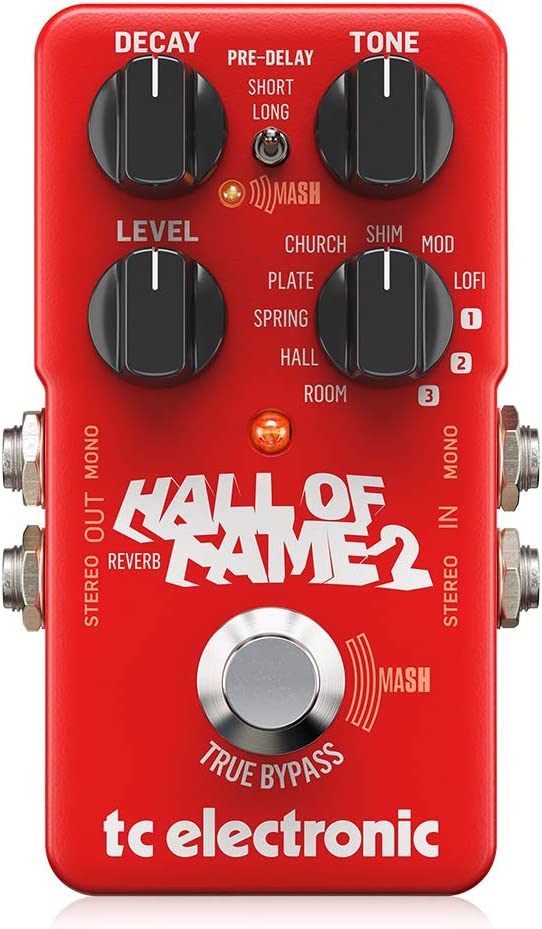
The TC Electronic Hall of Fame 2 Reverb Pedal is a versatile and innovative guitar effects pedal that offers a wide range of reverb options.
This multicolored pedal measures 5 x 3.5 x 3 inches and weighs 0.35 kilograms, making it compact and lightweight.
One of its notable features is the new MASH footswitch, which, combined with the shimmer effect, provides a unique and customizable sound experience.
The pedal also offers TonePrint, allowing users to access custom settings created by their favorite artists.
It can easily fit into any setup with stereo input and output options.
The true bypass feature ensures zero tone loss, while the analog-dry-through technology maintains tonal integrity and clarity.
With ten different reverb types, the Hall of Fame 2 covers a broad spectrum of reverb sounds, from natural room ambiance to cathedral-like echoes in outer space.
The pedal’s controls are user-friendly, with decay, tone, and fixed level knobs to fine-tune the sound.
As a result, the pedal suits experienced musicians who love to tweak their sound and those who prefer a simple, easy-to-use reverb effect.
- My Review
After experimenting with the TC Electronic Hall of Fame 2 Reverb Pedal, I was thoroughly impressed by its exceptional sound quality and versatility.
The compact and lightweight design allowed me to integrate it into my setup seamlessly, while the stereo input and output options provided additional flexibility.
One feature that stood out to me was the innovative MASH footswitch.
It allowed me to create unique and customizable sound experiences by combining them with the shimmer effect.
I also appreciated the TonePrint feature, which gave me access to custom settings that some of my favorite artists created.
It felt like having their expertise right at my fingertips.
As I explored the various reverb types, I found that the pedal covered various sounds, from natural room ambiance to cathedral-like echoes in outer space.
In addition, the user-friendly controls, including decay, tone, and fix level knobs, made fine-tuning the sound a breeze.
I particularly enjoyed the tone control, which allowed me to dial in the perfect brightness or warmth for each effect.
I did notice a couple of minor downsides.
First, although the shimmer effect was impressive, it could occasionally overpower my playing if I used it too much.
Here are the ratings I’ll give to the TC Electronic Hall of Fame 2 Reverb Pedal:
Furthermore, I found that some reverb types sounded quite alike, which might not appeal to those searching for more unique reverberations.
Despite these minor issues, I believe the Hall of Fame 2 is a great pedal for experienced musicians who love to tweak their sound and those who prefer a simple, easy-to-use reverb effect.
- Pros:
- Versatile reverb options.
- Innovative MASH footswitch.
- Easy-to-use controls.
- Cons:
- Shimmer effect can overpower.
- Some similar reverb types.
- Limited distinct reverberations.
My final verdict is that the TC Electronic Hall of Fame 2 Reverb Pedal offers versatility, features, and performance, making it a worthwhile addition to any musician’s pedalboard.
While minor drawbacks, such as the overpowering shimmer effect and limited distinct reverberations, the innovative MASH footswitch, user-friendly controls, and wide range of reverb options make it an appealing choice for guitarists seeking a high-quality reverb pedal.
Donner Reverb Guitar Pedal
Donner Reverb Pedal offers easy controls, true bypass, and 7 reverb modes for inspiring sound.
The Donner Vivid Series Pedal features an efficient chip, true bypass switch, and easy controls for wide flexibility. Its mini size allows you to take it anywhere, while the Verb Square feature ensures a fuller and more dynamic reverb sound. Perfect for studio or live use.
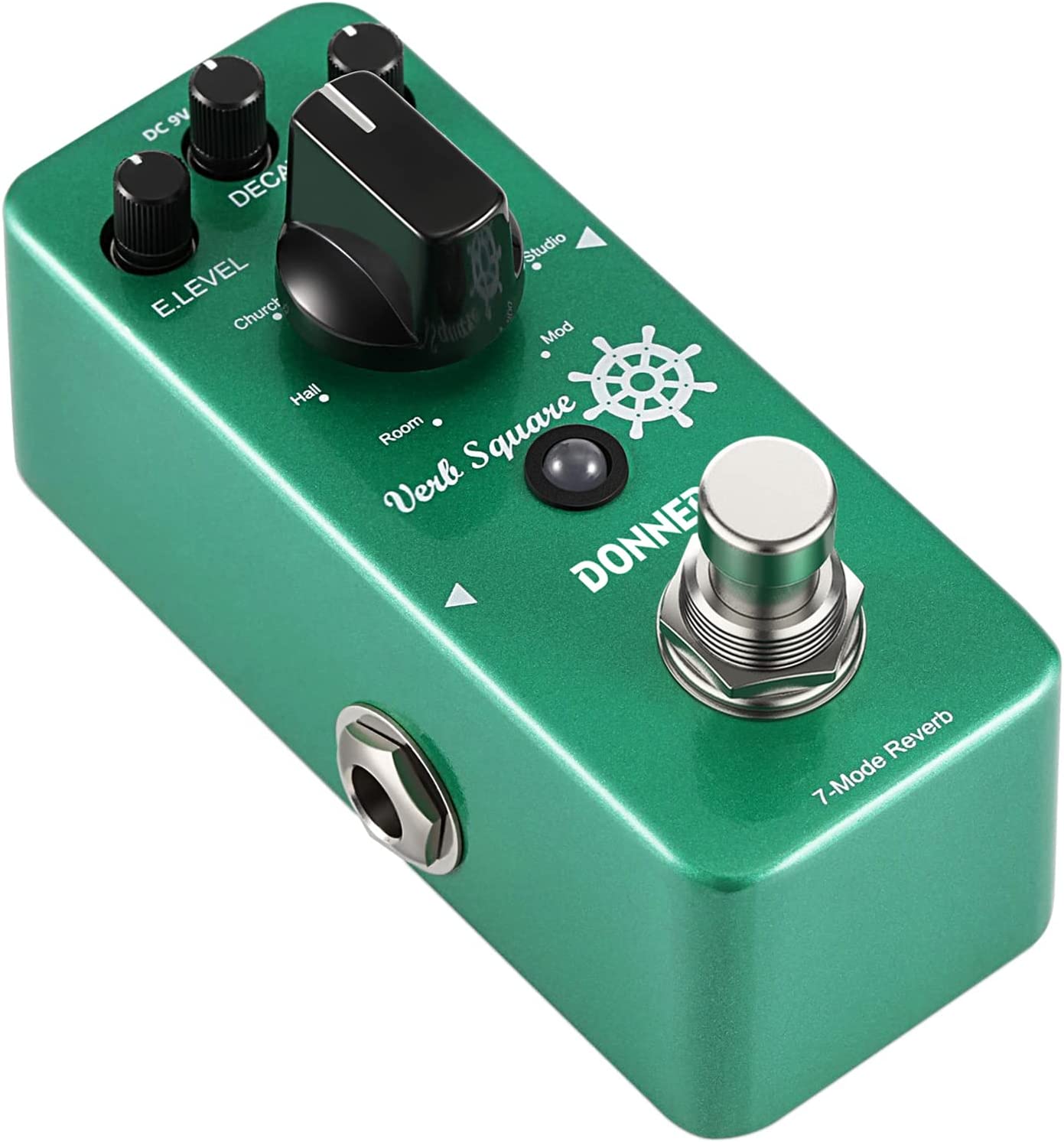
The Donner Reverb Guitar Pedal, or the Verb Square, is a versatile digital reverb pedal with seven distinct reverb effects to enhance your guitar-playing experience.
These effects include Room, Hall, Church, Spring, Plate, Studio, and Mod.
Designed with a digital circuit and true bypass, the pedal delivers a transparent tone without altering your instrument’s natural sound.
This green reverb pedal is stable and strong, constructed with durable aluminum alloy material.
An LED indicator on the pedal shows its working state, making it easy to see when it’s active.
In addition, the Donner Reverb Guitar Pedal’s compact dimensions (2.4 x 2.4 x 3.9 inches) and lightweight design (0.27 kilograms) make it convenient to carry and use with your guitar setup.
Please note that a DC 9V adapter power supply is required to operate the pedal but is not included in the product.
- My Review
Upon trying the Donner Reverb Guitar Pedal, I must say that it truly exceeded my expectations.
It’s a compact and well-built pedal that offers various reverb effects, perfect for adding depth and ambiance to my guitar playing.
With seven unique reverb modes, including Room, Hall, Church, Spring, Plate, Studio, and Mod, I found it effortless to dial in the perfect sound for any musical situation.
One aspect that stood out to me is the pedal’s digital circuit design and true bypass feature.
These qualities ensure that my guitar’s natural tone remains unaltered when the effect is disengaged, allowing for a transparent and authentic sound.
In addition, the aluminum-alloy construction gives this pedal a sturdy and stable feel and keeps it lightweight and portable.
Navigating the Donner Reverb Pedal was a breeze, thanks to its user-friendly controls and clear LED indicator.
The pedal’s compact dimensions (2.4 x 2.4 x 3.9 inches) and lightweight design (0.27 kilograms) make it an ideal addition to any pedalboard without occupying too much space.
On the other hand, one minor drawback is the absence of a power supply included with the pedal.
A separate DC 9V adapter is required to operate it, which might slightly inconvenience some users.
However, considering the pedal’s affordability and performance, this is a small compromise.
In my experience with the Donner Reverb Guitar Pedal, its versatility and quality make it a valuable addition to any guitarist’s gear collection.
Here are the ratings I’ll give to the Donner Reverb Guitar Pedal:
The range of reverb effects, sturdy build, and ease of use make it a pleasure to play with, and I highly recommend it to musicians seeking an affordable and reliable reverb pedal.
Just grab a power supply, and you’ll be good to go!
- Pros:
- Seven unique reverb effects.
- Sturdy aluminum-alloy construction.
- Compact and lightweight design.
- Cons:
- No power supply included.
- Some modes may be touchy.
- Limited tone control options.
My final verdict is that the Donner Reverb Guitar Pedal is a valuable addition to any guitarist’s setup, offering a variety of reverb effects, solid construction, and compact design.
Despite minor drawbacks, such as the absence of a power supply and limited tone control options, the pedal delivers excellent performance and tone quality at an affordable price point.
JOYO Atmosphere R-14 Reverb Pedal
JOYO provides professional digital products for music education with innovative features.
JOYO offers high-quality and innovative digital products for guitarists and music lovers, providing professional sound effects, advanced technology and easy-to-use features. Their pedals feature 9 built-in digital reverb types, metal casing, true bypass and an LED light for easy operation.
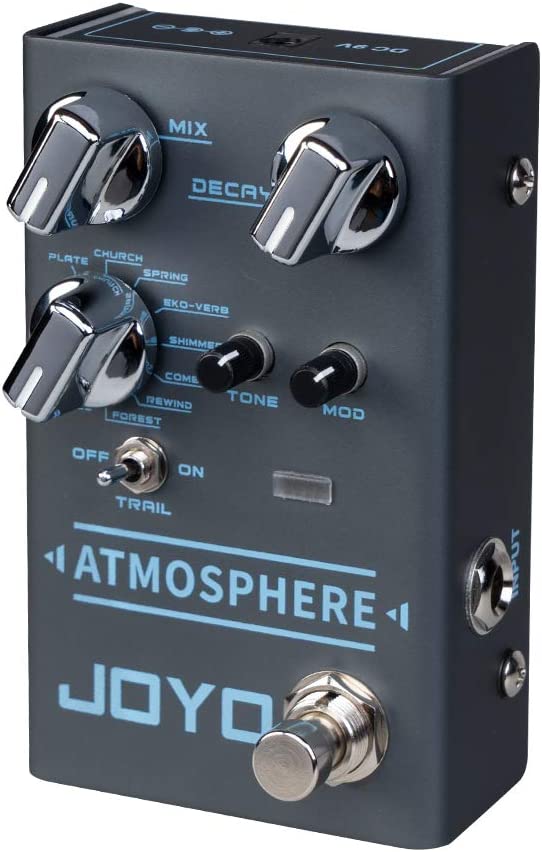
The JOYO Atmosphere R-14 is a reverb pedal designed for electric guitarists, offering a versatile range of digital reverb effects.
With nine built-in reverb types, including Spring, Church, Plate, Eko-Verb, Shimmer, Comet, Rewind, Forest, and Pulse, this pedal allows players to customize their sound to suit their preferences.
The Mix, Decay, and Tone controls can further adjust each effect.
One unique feature of the Atmosphere R-14 is its modulation effects depth control, which enables users to fine-tune the modulation effects for optimal performance.
The “Trail” function switch also provides a natural-sounding fade-out effect between turning the pedal on and off.
The pedal’s stylish design combines futuristic and retro elements, enhanced by its iconic ambiance lights.
JOYO has a decade-long reputation for producing high-quality, budget-friendly pedals and accessories, and the Atmosphere R-14 is no exception.
Before using the pedal, ensure that the guitar is properly connected.
To prevent any noise issues, it is recommended to use a reliable power adapter that meets the current working requirement of the pedal.
The pedal’s dimensions are 4.29 x 1.89 x 2.64 inches, weighing 248 grams.
It operates on a 9-volt DC voltage.
- My Review
After spending some time with the JOYO Atmosphere R-14, I concluded this reverb pedal offers much for electric guitarists.
With its nine digital reverb types, I explored many sonic landscapes, from the classic sounds of Spring and Plate reverbs to the more experimental vibes of Comet and Pulse.
In addition, the Mix, Decay, and Tone controls allowed me to tailor each effect to my liking further, and the modulation effects depth control added an extra layer of customization.
One aspect of the Atmosphere R-14 that stood out was the “Trail” function switch.
This feature made the transition between turning the pedal on and off much smoother, creating a more natural-sounding fade-out effect.
It’s a small detail, but it greatly impacted the overall performance.
Design-wise, the pedal looks fantastic, blending futuristic and retro elements with its iconic ambiance lights.
It’s a visually appealing addition to any pedalboard.
However, I encountered some issues during my time with the pedal.
I noticed a slight clicking or popping sound on several settings as the reverb was sustained.
This might not be a deal-breaker for some, but it could be an issue for those looking to record or perform with softer music.
Additionally, it’s important to use a reliable power adapter to avoid noise problems.
The pedal requires a 9-volt DC voltage, and using the right power adapter ensures optimal performance.
Despite a few small drawbacks, I think the JOYO Atmosphere R-14 is a well-crafted and versatile reverb pedal.
Here are the ratings I’ll give to the JOYO Atmosphere R-14 Reverb Pedal:
However, despite its imperfections, it offers a wide range of options and a stylish design, making it an attractive choice for guitarists looking to experiment with new sounds.
Moreover, it provides excellent value compared to high-end reverb pedals, making it an appealing option for those looking to try different reverb effects without spending too much money.
- Pros:
- 9 built-in digital reverb types.
- Modulation effects depth control.
- Futuristic and retro design.
- Cons:
- Some users report faulty units.
- Labeling of effects difficult to read.
- Power adapter not included.
My final verdict is that the JOYO Reverb Pedal offers a good variety of digital reverb types and features in its price range.
Still, some users may face issues with faulty units and the readability of labels.
It provides a decent value for guitarists looking for diverse reverb options.
Boss RV-6 Reverb Guitar Pedal
Lush ambient spaces with 8 reverb modes, expression pedal input, and legendary BOSS sound.
The RV-6 is a powerful pedal that provides high-end sound and wide-ranging reverb effects. From subtle rooms to shimmering modern tones to long, evocative reverbs, it creates lush, inspiring sounds quickly and easily.
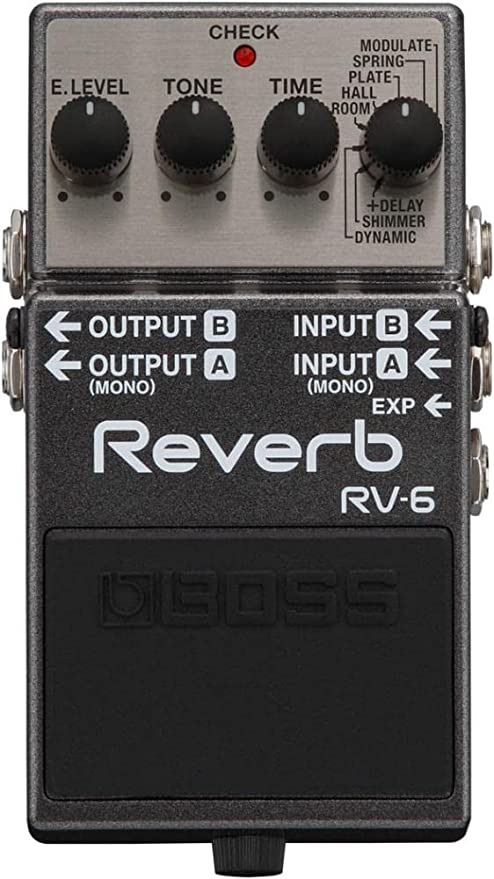
The Boss RV-6 Digital Reverb is a high-quality reverb pedal designed to bring a wide range of versatility in a compact package.
This powerful pedal offers eight different reverb modes, including classics like room, hall, spring, and plate, and unique options such as dynamic and shimmer.
Thanks to its cutting-edge technology and Boss’s expertise, you can instantly achieve amazing reverb tones.
This pedal is compatible with mono and stereo operations and has an expression pedal input for added control.
The Boss RV-6 is housed in a durable silver casing, measuring 5.95 x 3.8 x 2.7 inches and weighing just 0.45 kilograms, making it a reliable addition to your pedalboard.
Designed to provide endless inspiration, this pedal can produce everything from subtle room reverberations to modern shimmer effects and long, evocative reverbs.
The Boss RV-6 elevates pedal-based reverb, enveloping your tone in lush, ambient spaces that can enhance your music like never before.
- My Review
Having had the chance to try the Boss RV-6 Digital Reverb, I must say that this pedal truly lives up to the Boss name and reputation.
The first thing that caught my attention was the sturdy build and compact design, making it a reliable companion for gigs and jam sessions.
Diving into the features, I was quite impressed by the various reverb modes available.
The classics like room, hall, plate, and spring offered a nostalgic touch I truly appreciated.
On the other hand, the dynamic and shimmer modes opened up new sonic possibilities, making this pedal a versatile tool that could cater to diverse musical styles.
Adjusting the settings was a breeze, with intuitive knobs for effect level, tone, and time.
I found the reverb selection knob a bit tricky to read at first, but after some use, I became familiar with the positions of each reverb mode, so it wasn’t much of an issue.
In terms of sound quality, the RV-6 performs admirably.
The spring reverb, for example, captured the metallic response beautifully, while the plate and hall modes provided a rich, full-bodied sound.
The modulate mode, with its dreamy decay and subtle chorus-like modulation, was particularly mesmerizing.
However, when put up against some boutique reverb pedals, the RV-6 might not be as smooth or organic in its sound, but considering its price point, it’s still a fantastic value.
Here are the ratings I’ll give to the Boss RV-6 Reverb Guitar Pedal:
In my experience, the Boss RV-6 Digital Reverb is a well-rounded and versatile pedal that would make a great addition to any musician’s arsenal.
Although it might not be perfect, its sound quality and range of features make it a solid choice for those seeking a reliable and affordable reverb pedal.
- Pros:
- Wide variety of reverb modes.
- Durable and compact design.
- Intuitive controls and settings.
- Cons:
- Reverb selection knob hard to read.
- Less organic sound than boutique pedals.
- Shimmer mode may lack authenticity.
My final verdict is that the Boss RV-6 Digital Reverb is a highly versatile and reliable pedal that offers a wide range of reverb modes, solid performance, and great value for its price.
While it might not have the same organic sound as some boutique pedals, its durable design, intuitive controls, and reputable brand make it a strong choice for musicians seeking a quality reverb pedal.
Behringer DR600 Digital Stereo Reverb Pedal
Studio-grade reverb with 6 models, easy setup, and top-notch sound.
The BEHRINGER DIGITAL REVERB DR600 is an ultimate digital reverb effects pedal comparable to state-of-the-art studio processors, offering 6 stunning 24-bit high-resolution reverbs for a studio-grade sound. The DR600 is easy to use and includes a status LED, top-quality on/off switch, and dual output jacks for true stereo enhancement.
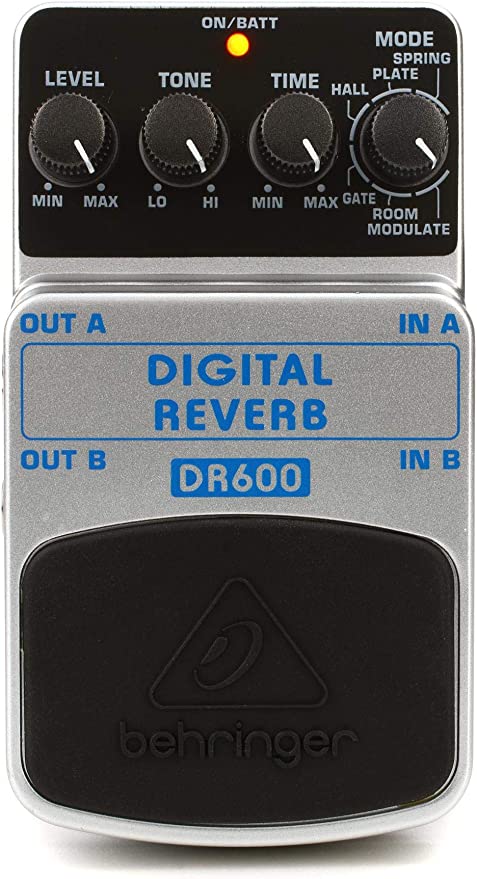
The Behringer DR600 Digital Reverb is a stereo effects pedal designed to provide various types of reverb for your musical performances.
With six different reverb models, including Spring, Plate, Hall, Gate, Room, and Modulate, you can easily tailor your sound to your preferences.
In addition, this pedal is equipped with stereo inputs and outputs, ensuring your sound has a rich and wide presence.
Constructed with a silver-colored plastic top material, the DR600 is designed for right-handed guitarists and can accommodate up to six strings.
This digital reverb pedal features dedicated Mode, Time, Tone, and Level controls, allowing you to shape your sound precisely.
Moreover, its high-quality components and rugged construction ensure durability and longevity.
The Behringer DR600 is a versatile and affordable option for those looking to add studio-grade reverb to their live gigs or home recordings.
- My Review
I had the opportunity to test the Behringer DR600 Digital Reverb pedal, and I must say that I was impressed with its quality despite its affordable price range.
This particular pedal provides various reverb types, such as Spring and Modulate, which enables musicians to explore a wide range of sounds.
Moreover, the Mode, Time, Tone, and Level controls allow easy sound customization to suit individual preferences.
All in all, this is a fantastic option for those who seek a reliable and versatile reverb pedal without breaking the bank.
One thing I noticed while playing with the DR600 is that the reverb can sometimes sound a bit artificial, especially when the Level control is turned up too high.
It’s not a deal-breaker but something to remember while dialing in your settings.
Additionally, the Mix control can be quite sensitive, so finding the perfect balance between wet and dry signals might take a bit of trial and error.
Something worth mentioning is the construction of the pedal itself.
While it’s built with a sturdy plastic material, it might not be the best choice for heavy gigging musicians who require a more robust metal casing.
However, the DR600 should hold up just fine for home use or occasional gigs.
I particularly enjoyed this pedal’s stereo inputs and outputs, as it offers a wider sound presence, which is a plus.
The blue LED indicator, however, can be quite blinding, so you might want to cover it with some tape or another solution to avoid distractions during your performance.
Battery life seems to be an issue for some users, but if you’re using a power supply, then it shouldn’t be a problem.
Just keep in mind that changing the battery can be a bit of a hassle.
Here are the ratings I’ll give to the Behringer DR600 Digital Stereo Reverb Pedal:
Ultimately, the Behringer DR600 Digital Reverb is a solid choice for those seeking an affordable reverb pedal with decent customization options.
While it may have minor drawbacks, its performance and value for money make it a worthwhile addition to any guitarist’s pedal collection.
- Pros:
- Wide variety of reverb types.
- Easy-to-use sound controls.
- Stereo inputs and outputs.
- Cons:
- Artificial sound at high levels.
- Sensitive Mix control.
- Plastic construction.
My final verdict is that the Behringer DR600 Digital Reverb Pedal offers a variety of reverb types and is easy to use with its dedicated sound controls.
The stereo inputs and outputs provide added versatility and deliver decent performance for its price range.
However, the tone quality may not be up to par with more expensive models, and the plastic construction may not be as durable as some competitors.
With its affordable price point, this pedal could be a good option for those on a budget or for occasional use.
Still, more serious musicians may want to consider investing in a higher-quality reverb pedal.
Electro Harmonix Cathedral Stereo Reverb Pedal
Infinite reverb possibilities with intuitive controls and 24-bit AD/DA.
Cathedral Stereo Reverb offers true stereo reverbs with programmability to create the perfect space for your instrument or voice. It includes wet/dry control, reverb time, dampening/tone, feedback, and pre-delay knobs, plus a mode knob to scroll through 8 modes, including Grail Spring, Accu Spring, Hall, Room, Plate, Reverse, Grail Flerb, and Echo.
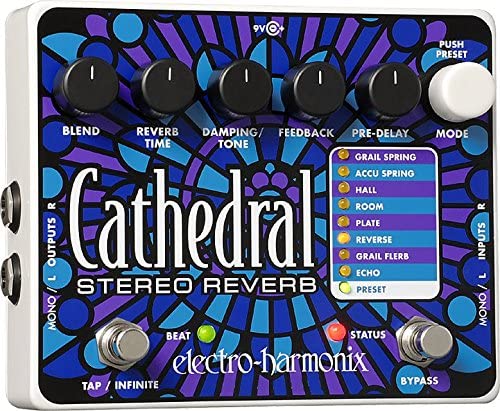
The Electro Harmonix Cathedral Stereo Reverb pedal it’s just fantastic!
It’s not just any reverb pedal; it’s a versatile and powerful one, offering a wide range of reverb options for musicians.
With true stereo inputs and outputs, you can trust it to deliver high-quality sound processing, thanks to its 24-bit AD and DA converters.
What’s cool about this pedal is that it has eight programmable reverb styles you can customize and save for later.
Plus, you can use the Tap Tempo feature to set the pre-delay section just the way you want it.
The Damping/Tone control for each reverb mode lets you fine-tune the sound perfectly.
The pedal has a sleek multi-color finish and measures 10 x 6 x 3 inches, weighing 0.9 kilograms.
It’s designed to create the perfect space for your instrument or voice, taking your performance to the next level.
Some other awesome features include a blend knob for wet/dry control, adjustable reverb time, and feedback control.
The Pre-Delay knob allows you to set the delay time for the reverb, and the Mode knob helps you scroll through the eight modes of the pedal.
Trust me, the Electro Harmonix Cathedral Stereo Reverb pedal has features to help you create the ideal reverb for your music!
- My Review
Let me tell you about my experience with the Electro Harmonix Cathedral Stereo Reverb pedal!
First, it’s not just your run-of-the-mill pedal; it’s a powerhouse offering a smorgasbord of reverb options.
With true stereo inputs and outputs, I knew I could rely on it for top-notch sound processing, thanks to the 24-bit AD and DA converters.
What stood out to me were its eight programmable reverb styles, which I could easily customize and save for later.
In addition, the Tap Tempo feature was a breeze, letting me set the pre-delay section just right.
And with dedicated Damping/Tone control for each reverb mode, it was a cinch to fine-tune my sound.
The pedal’s multi-color finish and compact size (10 x 6 x 3 inches) were perfect, and it was surprisingly lightweight at just 0.9 kilograms.
It felt like this pedal was designed to create the perfect space for my instrument, taking my performance to a new level.
Some other nifty features that caught my attention were the blend knob for wet/dry control, adjustable reverb time, and feedback control.
In addition, the Pre-Delay knob allowed me to set the delay time for the reverb, while the Mode knob let me scroll through the eight modes like a walk in the park.
Now, nothing is perfect, and there were a few minor issues, like the paint finish on the unit, which could’ve been better, and sometimes the reverb might feel a bit too synthetic in some settings.
Here are the ratings I’ll give to the Electro Harmonix Cathedral Stereo Reverb Pedal:
However, the Electro Harmonix Cathedral Stereo Reverb pedal’s versatility and impressive range of features more than make up for these minor drawbacks.
In my experience, this pedal has been like a Swiss Army knife of reverb options, and I’ve been able to craft some amazing sounds with it.
- Pros:
- Versatile reverb options.
- True stereo inputs/outputs.
- Customizable and programmable.
- Cons:
- Paint finish could be better.
- Some settings sound synthetic.
- Minor digital whine issue.
My final verdict is that the Electro Harmonix Cathedral Stereo Reverb pedal is an excellent choice for musicians seeking versatile reverb options, customizable features, and high-quality sound.
Although there may be some small drawbacks, the pedal’s overall performance, tone, and positive brand reputation make it a worthwhile inclusion on any pedalboard.
AZOR AP311 Spring Reverb Pedal
Authentic spring reverb, timeless design, lightweight and portable.
AZOR Reverb Guitar Effect Pedal Verb Square offers a natural analog reverb sound, with an intuitive control panel and true bypass for zero-tone coloration. Comes with a full metal shell and LED indicator for easy operation. Ideal for guitarists seeking a professional-grade reverb pedal.
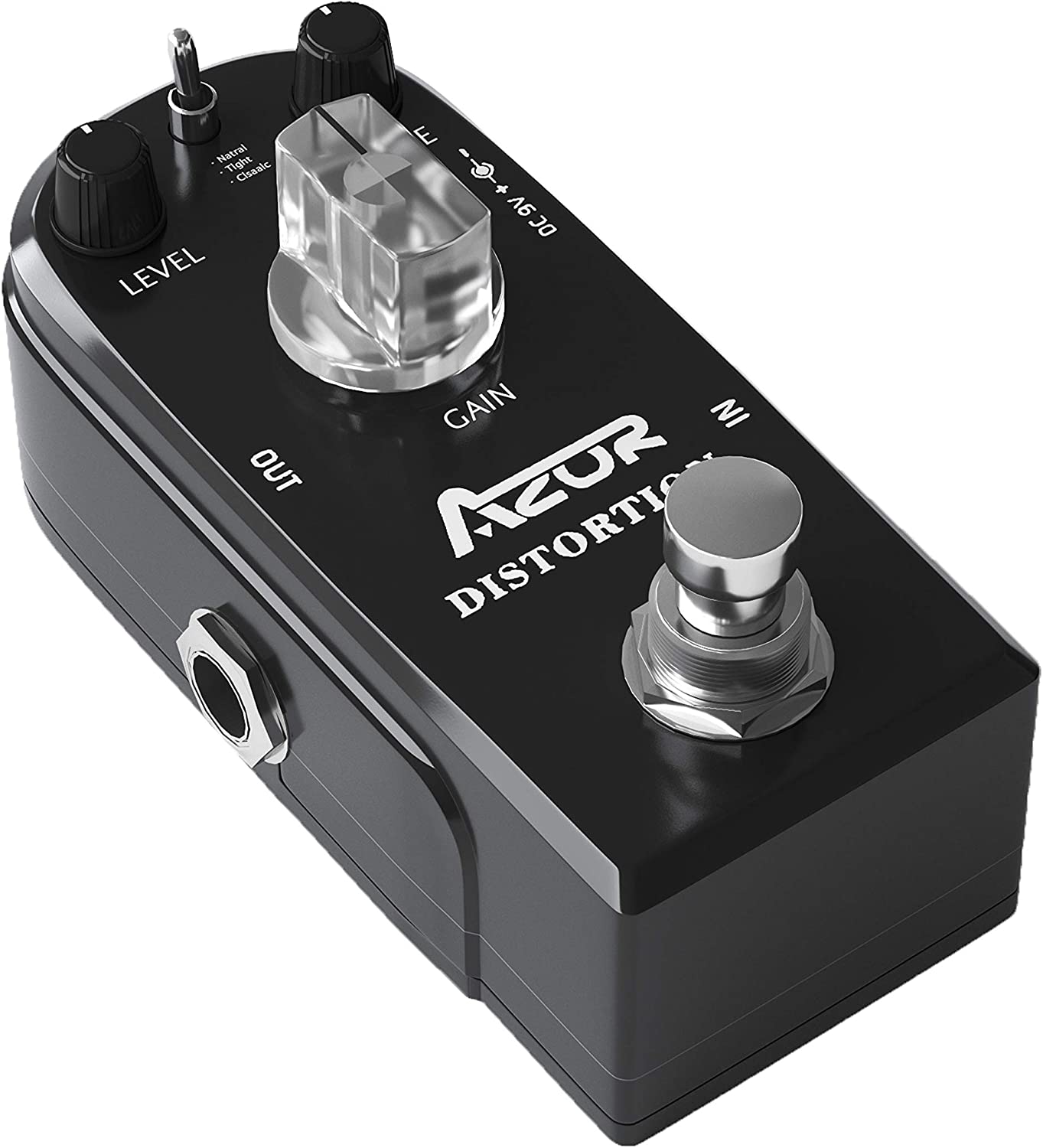
AZOR AP311 Spring Reverb is a guitar effect pedal that offers an authentic spring reverb effect similar to the ones found in vintage amplifiers.
This pedal’s design is compact and portable, making it easy to carry around and store.
The pedal’s case is made from aluminum alloy, providing stability and durability.
Moreover, the true bypass feature ensures a transparent tone.
The AP311 Spring Reverb pedal is powered by a 9V DC adapter with a center-negative, although the adapter is not included in the package.
The pedal’s dimensions are 3.7 x 1.7 x 1.3 inches and it operate at 9 volts.
This reverb pedal is designed for easy use, with input and output jacks for 1/4″ monaural cables and power requirements of an AC adapter 9V DC.
AZOR has been known for producing high-quality, affordable musical instruments and accessories since 2016.
The AP311 Spring Reverb pedal has a one-year warranty, giving customers peace of mind and confidence in purchasing.
- My Review
Having tried the AZOR AP311 Spring Reverb Guitar Effect Pedal, I can confidently say that it delivers a genuine spring reverb effect that harkens back to the classic tones of vintage amplifiers.
In addition, the compact and portable design makes it easy to carry around, while the aluminum alloy case ensures durability and stability, even during rigorous use.
One thing that stood out to me was the true bypass feature, which allows for a transparent tone without any signal loss.
This is especially important for maintaining the integrity of your guitar sound when using multiple effects in a chain.
Upon plugging in my guitar, I found the AP311 controls intuitive and easy to use.
Adjusting the reverb effect was a breeze, and I could dial in a wide range of sounds, from subtle ambiance to cavernous echoes.
The pedal’s compatibility with a 9V DC adapter (center-negative) is convenient, though it’s worth noting that the adapter is not included in the package.
Here are the ratings I’ll give to the AZOR AP311 Spring Reverb Pedal:
Despite the pedal’s many positive aspects, I noticed a slight noise issue when engaged.
This may not be a deal-breaker for some users, especially given the pedal’s affordable price point, but it’s worth considering for those who require a completely noiseless setup.
- Pros:
- Authentic spring reverb effect.
- Compact, durable design.
- Affordable price point.
- Cons:
- Noise issue when engaged.
- 9V DC adapter not included.
- Limited range of reverb sounds.
My final verdict is that the AZOR AP311 Spring Reverb Guitar Effect Pedal is a solid choice for guitarists seeking an authentic spring reverb effect in a compact and durable design at an affordable price.
While it may have some limitations regarding versatility and noise, its overall value makes it a worthwhile addition to a guitarist’s pedalboard.
FLAMMA FS02 Stereo Digital Effects Pedal
FLAMMA FS02 Reverb Pedal provides digital effects and 7 storable preset slots with true bypass and Trail On functions.
The FS02 reverb pedal from Flamma is a compact, metal-shelled pedal with 7 digital reverb effects from small rooms to open caves. It features knobs for Hi-Cut, Lo-Cut, Decay, and Pre-Delay plus save slots, optional routing, and a Trail On function for smooth transitions. Perfect for beginners and pros alike.
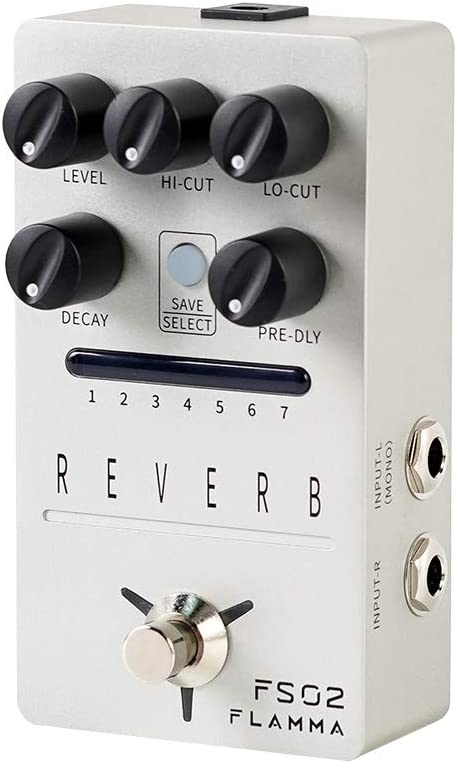
The FLAMMA FS02 Reverb Guitar Pedal is a high-quality, feature-packed effects pedal designed for guitarists seeking a range of classic reverb tones.
This pedal offers seven different reverb effects, including Room, Hall, Church, Cave, Plate, Spring, and Mod, each with its storable preset slot.
With stereo inputs and outputs, the FS02 provides an immersive sound experience.
This versatile reverb pedal allows users to fine-tune their sound with Hi-Cut, Lo-Cut, Decay, and Pre-Delay knobs, enabling them to create and save their unique tones.
In addition, the true bypass feature ensures minimal signal loss, while the Trail On function allows effects to fade out naturally, maintaining smooth performance.
The FLAMMA FS02 is housed in a sturdy metal shell with dimensions of 2.75 x 4.79 x 1.99 inches, weighing 0.3 kilograms.
This compact design makes it easy to incorporate into any pedalboard setup.
- My Review
Having spent some time with the FLAMMA FS02 Reverb Guitar Pedal, I must say it’s an impressive piece of gear.
The sturdy metal shell and compact design make it a welcome addition to my pedalboard, and the variety of reverb effects has expanded my tonal palette.
The seven classic reverb effects – Room, Hall, Church, Cave, Plate, Spring, and Mod – each have unique character and offer many sonic possibilities.
I particularly enjoyed the Plate setting, which gives a studio-quality reverb that takes my sound to another level.
In addition, the ability to tweak and store presets for each effect is a game-changer, making it easy to find the perfect tone and switch between different sounds during performances.
One feature I appreciated was the true bypass, which keeps my signal clean and free of unwanted noise.
Additionally, the Trail On function allows the reverb to fade out naturally when the effect is turned off, making a smooth transition between song parts.
However, it’s not all sunshine and roses.
While the stereo input and output are a nice touch, the pedal didn’t provide a true mono output, which could be an issue for some players depending on their setup.
Also, the low-cut option didn’t quite meet my expectations, as it didn’t effectively separate the low frequencies from the reverb effect, resulting in a slightly muddy sound at times.
Despite these minor drawbacks, I believe the FLAMMA FS02 Reverb Guitar Pedal offers great value for its price.
Here are the ratings I’ll give to the FLAMMA FS02 Stereo Digital Effects Pedal:
The vast array of reverb effects, user-friendly interface, and solid construction make it a fantastic choice for guitarists looking to expand their sonic horizons.
While it may not be perfect, it’s a worthy addition to any musician’s collection.
- Pros:
- Seven reverb effects and presets.
- User-friendly interface and controls.
- Sturdy, compact design.
- Cons:
- Low cut option not very effective.
- Some reverb tones less impressive.
- Limited brand recognition.
My final verdict is that the FLAMMA FS02 Reverb Guitar Pedal offers a great combination of versatility, features, and value for its price.
While it has minor drawbacks, such as the low cut option not being as effective as desired, the variety of reverb effects, user-friendly interface, and solid construction make it a fantastic choice for guitarists looking to expand their sonic horizons.
This pedal is a worthy addition to any musician’s collection, providing a range of creative possibilities for both live performances and studio recordings.
MXR M300 Reverb Guitar Effects Pedal
MXR Reverb Guitar Effects Pedal: Six meticulous reverbs in one pedal.
MXR Reverb offers six ultra-realistic reverb styles, Hi-Fi analog dry path, and three-knob setup. Connect a Dunlop dvp series volume/expression pedal to the expression jack to toggle and blend settings. 100% wet mode, stereo input/output, and true relay/trails bypass make it perfect for studio recording.
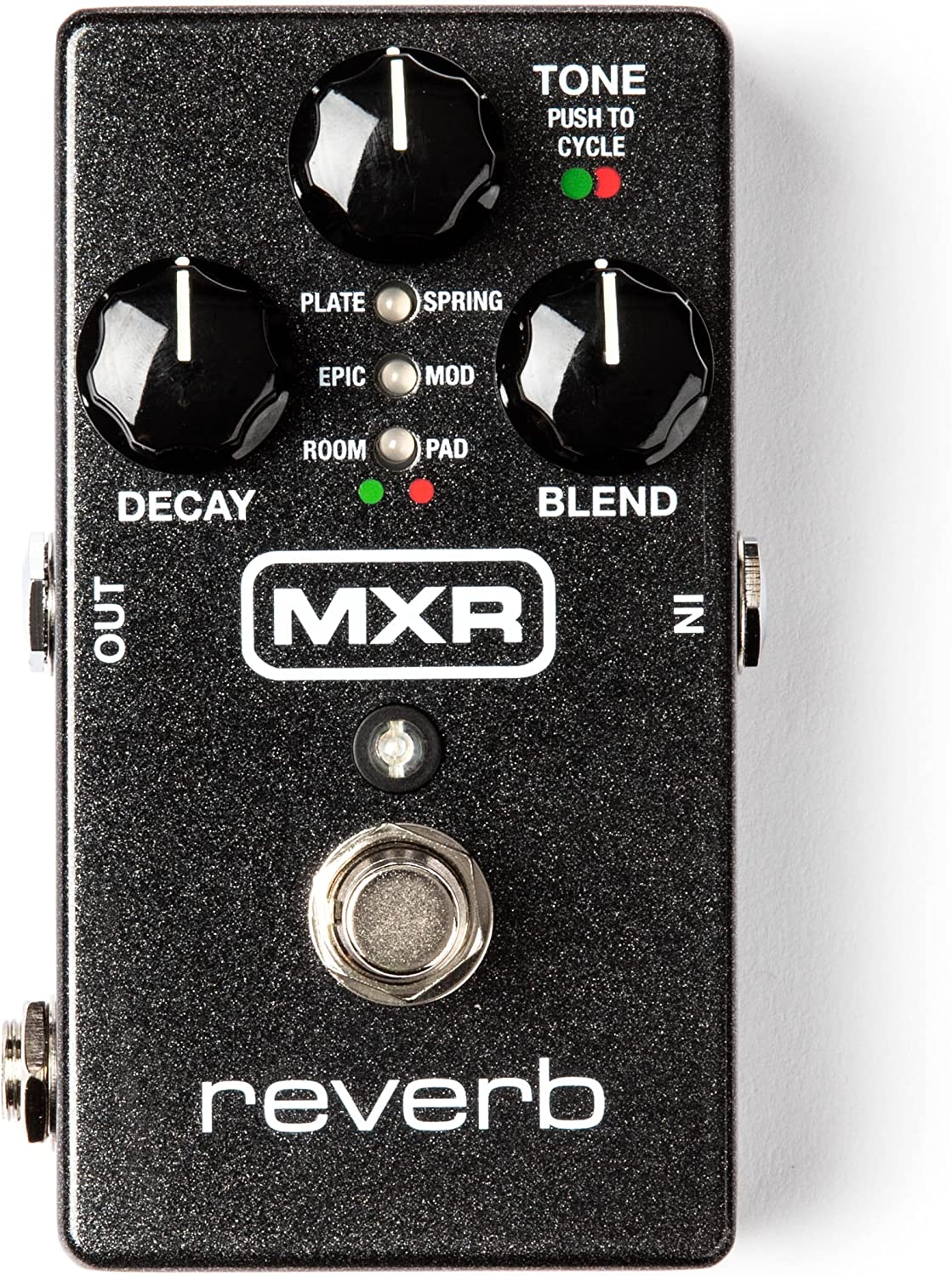
The MXR Reverb Guitar Effects Pedal is a versatile, high-quality pedal for guitar enthusiasts exploring different reverb styles.
This compact pedal, developed by Jim Dunlop, offers six carefully crafted reverbs, ensuring a wide range of sound options for various genres.
In addition, its 100% analog dry path provides a studio-grade low-noise floor and a massive 20 volts of headroom, courtesy of the constant headroom technology.
Navigating through the reverb styles is as simple as pushing the tone knob, giving users easy access to plate, spring, epic, mod, room, and pad settings.
The MXR Reverb pedal delivers rich, detailed reverbs comparable to those in high-end rack units and plug-ins.
Additionally, it features stereo input and output capability, true relay or trails bypass, and can be connected to a Dunlop DVP series volume/expression pedal for added control.
With its sleek black design and solid construction, the MXR Reverb Guitar Effects Pedal is an excellent addition to any guitarist’s pedalboard.
- My Review
Having spent ample time exploring the MXR Reverb Guitar Effects Pedal, I must say it’s a versatile and highly capable piece of equipment for any guitarist’s arsenal.
The six distinct reverb styles – plate, spring, epic, mod, room, and pad – offer various sound options, catering to various musical genres and tastes.
The plate setting, for example, provides a smooth, shimmering wash of space reminiscent of classic studio recordings, while the spring setting impeccably emulates the iconic amp-based effect.
With its interwoven analog-tone delay lines and complex modulation, the epic reverb transports you to a more ethereal, otherworldly sonic landscape.
On the other hand, the mod setting adds a touch of organic modulation to the plate-style spaciousness, perfect for creating a more immersive atmosphere.
The room and pad settings offer even more options, with the former adding subtle body and projection to your tone and blending sub-octave, octave-up, echoes, shimmer, and synth/organ modulation.
Despite its features, the MXR Reverb pedal maintains a user-friendly interface with a simple three-knob setup and a hi-fi analog dry path.
One small caveat is the slight background hiss that some users may experience when not using an isolated power supply.
However, investing in a decent isolated power supply brick can easily resolve this issue.
Here are the ratings I’ll give to the MXR M300 Reverb Guitar Effects Pedal:
In terms of build quality, the pedal boasts a sleek black design and solid construction, ensuring it can withstand the rigors of regular use.
In addition, the stereo input and output capability and the true relay or trail bypass further enhance its versatility and appeal.
- Pros:
- Six distinct reverb styles.
- User-friendly interface.
- Durable and sleek design.
- Cons:
- Potential background hiss.
- Higher price point.
- Requires isolated power supply.
My final verdict is that the MXR Reverb Guitar Effects Pedal is a highly versatile and well-crafted pedal that offers a wide range of high-quality reverb styles.
Its user-friendly interface, excellent tone, and solid performance make it a valuable addition to any guitarist’s setup.
Although the price point is higher than some alternatives, the pedal’s features and brand reputation justify the investment.
JHS Pedals 3 Series Reverb Pedal
JHS Pedals 3 Series Reverb: Versatile reverb with huge range of options.
JHS Pedals 3 Series Reverb combines classic reverberation effects with modern features like EQ, Pre-Delay, and 9V DC Negative Center power for a wide range of ambient sounds. It’s perfect for creating small room tones to near-endless washes of ambiance.
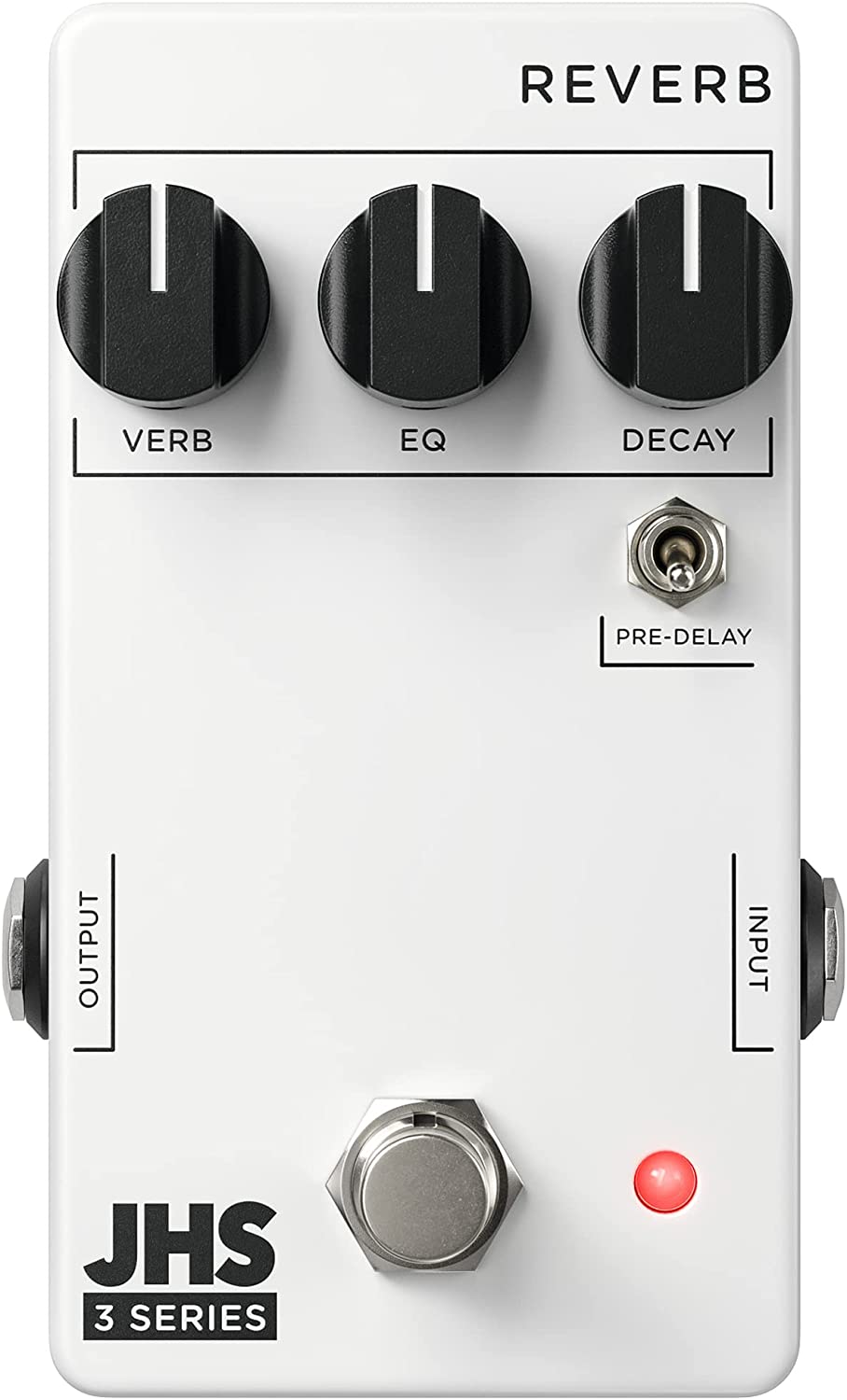
The JHS Pedals 3 Series Reverb is a versatile reverb pedal crafted in Kansas City, USA.
It is designed to help you achieve a wide range of reverberation effects, from subtle room sounds to vast, ambient washes.
With its EQ control, you can easily tweak the reverb’s tone to be bright or dark, depending on your preference.
The pedal also features a Pre-Delay knob that lets you select a short delay before the reverb kicks in, allowing you to experiment with various effects like slapback echoes or spacious spring-like sounds.
This reverb pedal is compatible with a 9V DC Negative Center power supply and consumes 74mA.
It has a sleek silver, white, and black color design and measures 4 x 3 x 2 inches, weighing 0.21 kilograms.
Part of the JHS Pedals 3 Series, this reverb pedal is a valuable addition to any guitarist’s setup, offering a simple yet powerful way to enhance your sound and create the perfect ambiance for your playing style.
- My Review
I recently got my hands on the JHS Pedals 3 Series Reverb, and I have to say, this pedal has been a game-changer for my guitar setup.
Its remarkable versatility allows me to create the perfect ambiance for any musical genre I’m exploring.
I immediately noticed how easy it is to adjust for a bright or dark tone using the EQ control.
This feature is handy when trying to find that sweet spot in my sound.
I also appreciate the Pre-Delay knob, which lets me choose a brief delay before the reverb starts.
It’s great for experimenting with different effects like splashy echoes or more spacious spring-like reverbs.
The JHS Pedals 3 Series Reverb has a sleek and sturdy design that doesn’t take up too much space on my pedalboard.
It’s lightweight yet durable, making it an excellent choice for gigging musicians constantly on the move.
Though versatile, some might find the pedal slightly muddy in certain settings.
However, once you get the hang of adjusting the controls, it’s not difficult to dial in your desired sound.
Remember that this pedal requires an isolated power supply or a dedicated adapter, which could be an extra expense for some.
In my experience, the JHS Pedals 3 Series Reverb has breathed new life into my guitar’s sound.
Here are the ratings I’ll give to the JHS Pedals 3 Series Reverb Pedal:
Its ability to provide anything from barely-there reverb to massive ambient washes makes it an invaluable asset for crafting unique tones.
Although it might take some tweaking to find the perfect settings, this reverb pedal is well worth the effort.
- Pros:
- Extremely versatile reverb effects.
- Easy-to-use EQ and Pre-Delay controls.
- Durable and sleek design.
- Cons:
- Requires isolated power supply.
- Slight volume boost at unity gain.
- Can be muddy in some settings.
My final verdict is that the JHS Pedals 3 Series Reverb is a solid choice for guitarists seeking a versatile and affordable reverb pedal.
Its impressive range of features and ability to create various reverberation effects offer great value and performance for its price.
Strymon NightSky Reverb Pedal
Create cosmic soundscapes with Strymon NightSky Reverberator Pedal.
NightSky is an innovative reverb pedal with a variable rate core and comprehensive sound-shaping features, allowing for mind-bending pitch and harmonic manipulation of reverb tails. Create vast soundscapes with just a few notes from your instrument, and explore a new universe of reverberant possibilities.
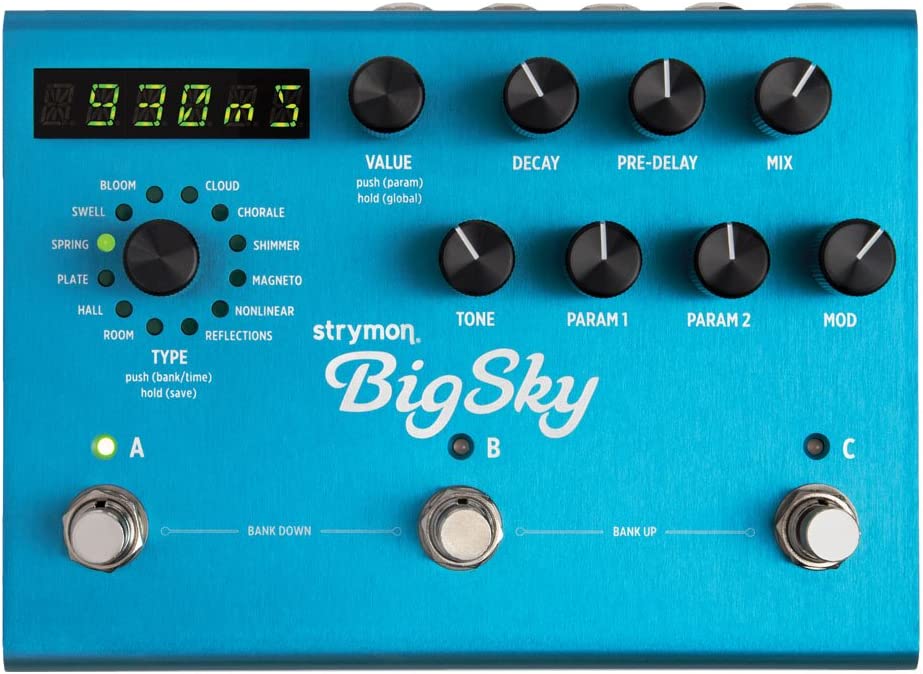
The Strymon NightSky Reverberator Pedal is a unique stereo reverb pedal that offers 300 presets and allows you to switch between buffered and true bypass.
Designed for musicians who love to experiment with sound, this pedal has versatile features that let you create vast soundscapes with just a few notes.
With modulated harmonic reverb generation options and an 8-step sequencer, the NightSky pedal provides new sound possibilities.
This pedal has three distinct reverb textures: granular-sounding Sparse, dense Plate-like, and slow-building atmospheric Diffuse.
Its modulation section, 4-pole resonant filter, and harmonic structure voice selection ensure that you have complete control over shaping your sound.
In addition, the pedal is housed in a durable case with dimensions 4.5 x 6.98 x 1.75 inches and weighs 2.1 pounds, ensuring it can withstand regular use.
Besides its numerous features, the NightSky Reverberator Pedal is powered by a 9-volt voltage.
It is built by Strymon, a reputable brand renowned for its quality and innovation in creating high-end effects pedals.
- My Review
I had the pleasure of trying the Strymon NightSky Reverberator Pedal, and I must say, I was blown away.
As soon as I began playing with it, I was transported to a galaxy of ethereal soundscapes.
It’s like opening a secret door into the realm of reverberation possibilities.
At first, the NightSky can seem intimidating due to its vast features.
But once you dive in, you’ll find that it offers boundless room for creativity and exploration.
For example, with its three distinct reverb textures – Sparse, Dense, and Diffuse – I experimented with everything from clean, open reverbs to lush, dense soundscapes.
One of the striking attributes of this pedal is its modulation capabilities.
I loved how I could add motion to my sounds, from slow, evolving textures to wild, experimental aural adventures.
The NightSky truly lives up to its name; it feels like riding a spaceship through an endless galaxy of sound.
The control layout lets you sculpt your perfect reverb, and it’s impressive how far you can go without getting lost in a sea of knobs and switches.
In addition, I appreciated the dedicated controls on every parameter, allowing immediate and intuitive music-making.
And let’s not forget the overall quality and craftsmanship of the NightSky.
Strymon has done a splendid job creating a sturdy and reliable pedal that can withstand heavy use on stage or in the studio.
While the cost may seem steep, it’s an investment worth considering for the incredible versatility and unique sound possibilities offered.
However, there’s a learning curve with all the features, which can be overwhelming for some.
But by dedicating some time to understanding and exploring the NightSky, its true potential begins to unfold, and I assure you, it’s an exquisite journey.
Here are the ratings I’ll give to the Strymon NightSky Reverb Pedal:
The Strymon NightSky Reverberator Pedal is more than a simple effects unit; it’s a sonic interstellar playground that sparks creativity and stretches the boundaries of what reverb can do.
So, buckle up and prepare to travel through the cosmos of sound with this incredible pedal.
- Pros:
- Vast sound possibilities.
- Intuitive, dedicated controls.
- Durable and reliable build.
- Cons:
- Steep learning curve.
- Higher price point.
- Potential overwhelm for beginners.
My final verdict is that the Strymon NightSky Reverberator Pedal is an exceptional, high-quality pedal that offers an expansive range of sound possibilities and features.
Its innovative design and powerful performance make it an excellent addition to any musician’s pedalboard, despite its higher price point and initial learning curve.
Fathom Multi-Function Reverb Pedal
Walrus Audio’s Fathom Multi-Function Reverb provides custom reverb algorithms, smart bypass switching, and sustain mode.
Walrus Audio offers a range of high-quality, feature-rich reverb pedals featuring four customized algorithms and toggle switches for low, medium and high modulation. Easily switch between small room reverb and long, modulated trails with the dampen knob to fine-tune the tone. Momentary functions and trails mode add creative opportunities, while the isolated power supply ensures a clean signal.
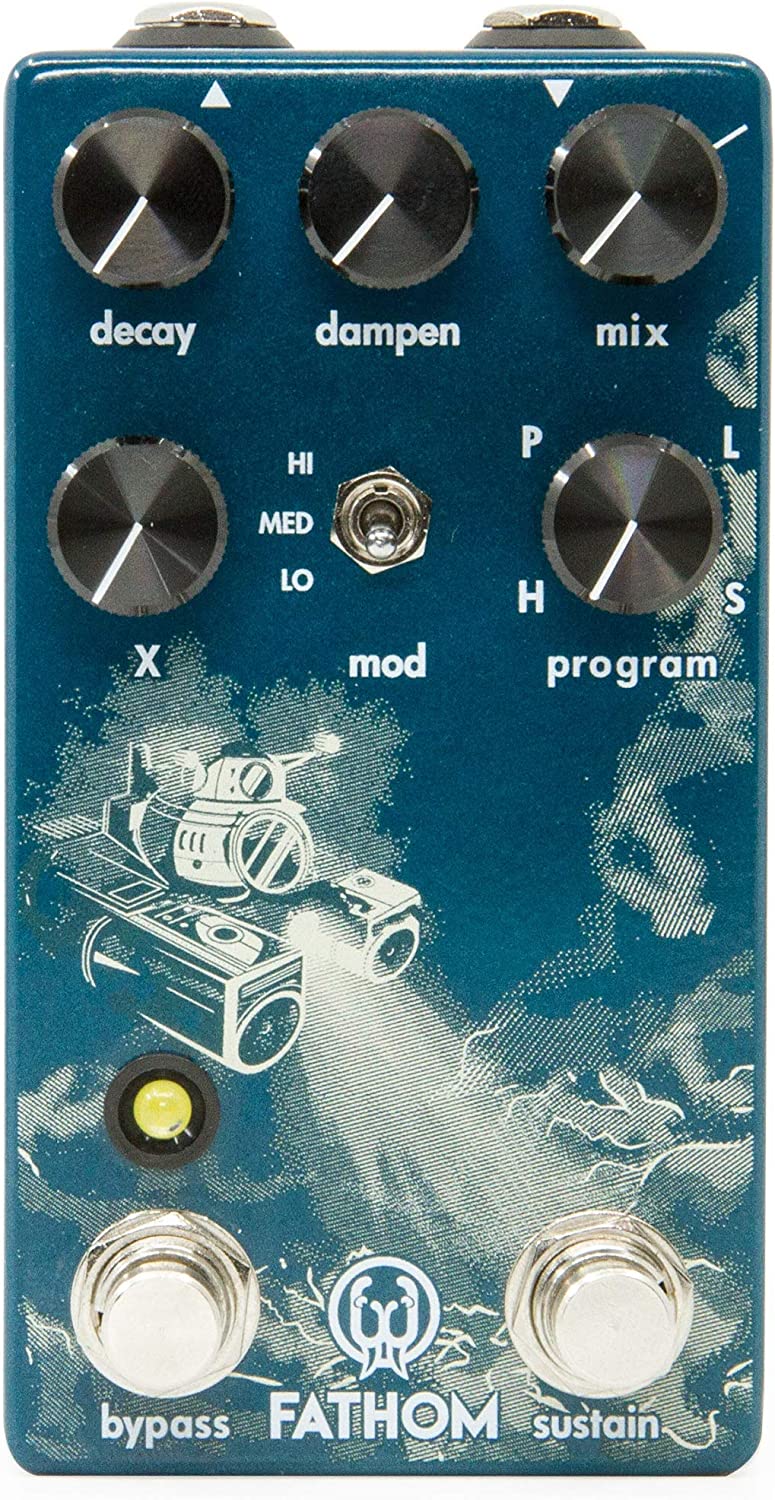
The Fathom Multi-Function Reverb is a versatile, feature-packed reverb pedal made by Walrus Audio, perfect for guitarists seeking to explore a variety of reverberation effects.
With four custom algorithms – Hall, Plate, Lo-Fi, and Sonar – this pedal offers a wide range of sounds, from subtle, small room reverb to expansive, modulated trails.
Additionally, a toggle switch provides modulation options with low, medium, and high settings to fine-tune the reverb’s decay tone.
The Hall setting gives an open, vast sound with decays that feature high-frequency roll off, while the Plate setting delivers full-bodied reverb with a smooth decay.
The Lo-Fi option presents a filtered reverb sound with decays ranging from warm to thin, reminiscent of an AM radio sound.
The innovative Sonar setting combines reverb with high and low octaves, offering a unique blend adjustable with the X knob.
This turquoise-colored pedal, featuring original artwork by Stuart Dooley, measures 6 x 5 x 3 inches and weighs 0.3 kilograms.
An isolated power supply is recommended to achieve the best performance, as daisy chain power supplies are not advised.
- My Review
Upon trying the Fathom Multi-Function Reverb pedal, I was immediately impressed with its variety of reverberation effects.
The pedal’s four custom algorithms – Hall, Plate, Lo-Fi, and Sonar – provide a wide spectrum of sounds, allowing me to experiment and fine-tune my guitar’s tone.
I was drawn towards the Hall setting for its spaciousness and the way it envelopes my sound in an expansive, atmospheric quality.
Although I appreciated the Plate’s full-bodied reverb with its smooth decay, the Lo-Fi algorithm truly piqued my interest.
This filtered reverb added warmth and an intriguing, vintage radio-like quality to my playing, which provided an unconventional twist to my sound.
On the other hand, the Sonar setting, with its high and low octave blending capability, introduced a distinctive texture akin to diving into a sonic adventure beneath the ocean surface.
However, I did find the lack of an included power supply a tad inconvenient, and the device’s recommendation for an isolated power supply could have been clearer.
As a result, I had to research further to determine power requirements and even invest in a separate isolated power supply for the best performance.
Aesthetically, the Arizona Teal finish with Stuart Dooley’s artwork adds a touch of artistic flair to my pedalboard.
With its sleek design and sturdy construction, the Fathom Multi-Function Reverb scores high on usability and durability.
So, while the Fathom Multi-Function Reverb isn’t perfect, its versatility and depth make it an invaluable addition to any guitarist’s arsenal.
Here are the ratings I’ll give to the Fathom Multi-Function Reverb Pedal:
In addition, the pedal’s ability to generate a wide array of room settings and ambient, modulated trails brings forth creativity and inspiration, just like a breath of fresh air in the world of reverb pedals.
Despite the power supply inconvenience, I wholeheartedly recommend this pedal to those seeking unique and diverse reverb sounds.
- Pros:
- Versatile reverb algorithms.
- Unique Lo-Fi and Sonar settings.
- Stylish design and artwork.
- Cons:
- No included power supply.
- Requires isolated power supply.
- Power requirement information unclear.
My final verdict is that the Fathom Multi-Function Reverb is an excellent pedal for guitarists seeking versatile reverb options and unique sound combinations.
Its broad range of algorithms, engaging design, and expansive tonal capabilities make it a remarkable investment for those looking to enhance their sound and creativity.
However, the lack of an included power supply and the need for an isolated one may cause some inconvenience.
Despite this, the Fathom Multi-Function Reverb remains a highly recommended addition to any musician’s gear collection.
MXR Reverb Guitar Effects Pedal
MXR Reverb offers 6 high-end reverb styles with studio-grade quality.
The MXR Reverb pedal offers six distinct reverb styles, each crafted with high-end detail and a Hi-Fi analog dry path. The pedal includes a unique blend of sub-octave, octave-up, echoes, and synth/organ modulation, as well as a 100% wet mode and stereo input/output capability.
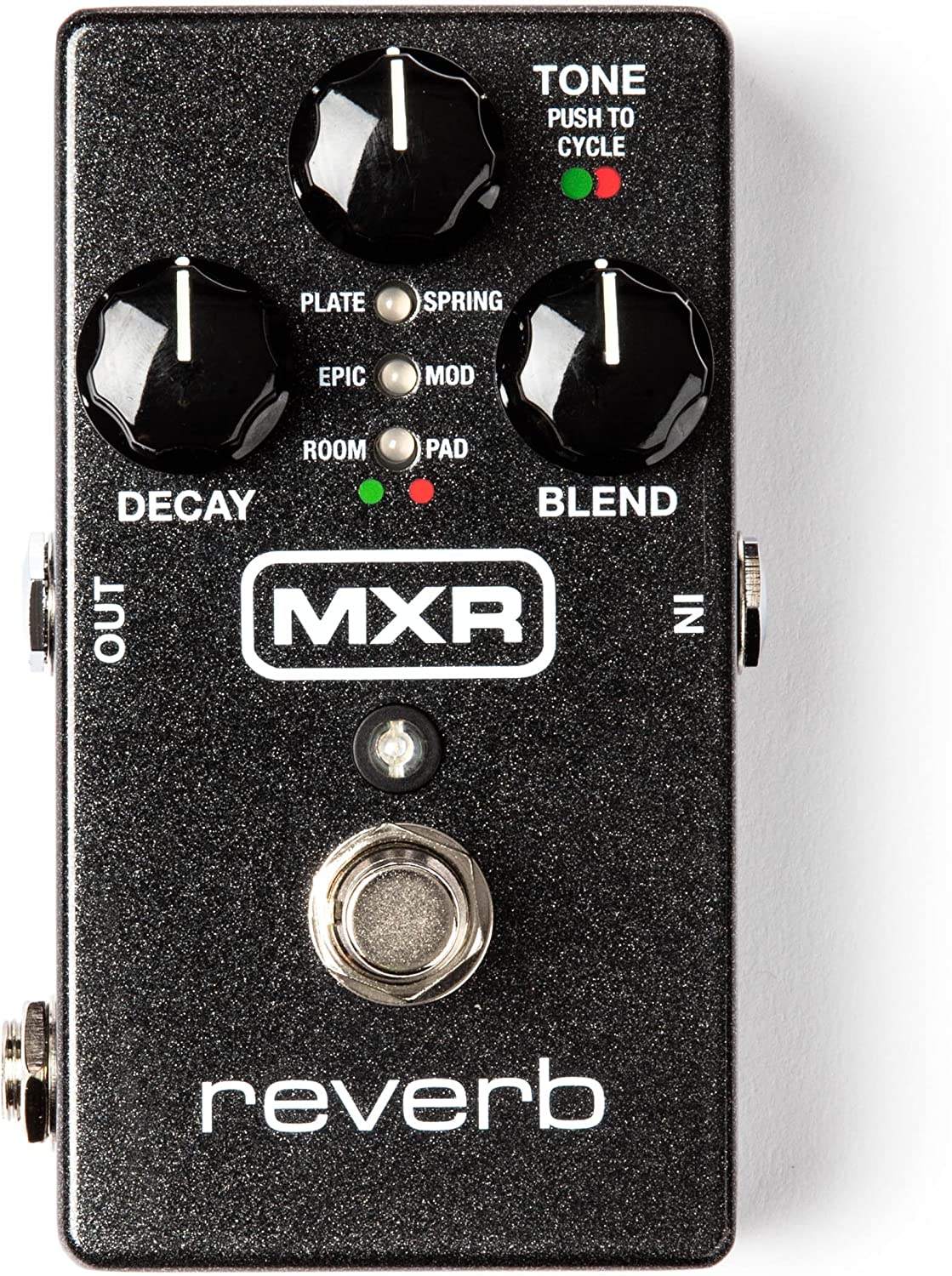
The MXR Reverb Guitar Effects Pedal is a versatile, high-quality pedal designed for guitarists looking to enhance their sound with various meticulously crafted reverbs.
This compact pedal packs six different reverb styles, each expertly tuned by the renowned MXR design team.
The unit’s 100% analog dry path offers excellent sound quality and a 20-volt headroom thanks to its constant headroom technology.
The simple three-knob setup makes it easy to switch between reverb styles, which include plate, spring, epic, mod, room, and pad.
Each style delivers a unique and rich sound ideal for various musical genres and playing styles.
Additionally, the pedal features a low-noise floor and can be connected to a Dunlop DVP series volume/expression pedal for extra control and customization.
The MXR Reverb pedal is housed in a durable, standard-sized MXR box and comes in a sleek black color.
Its dimensions measure 5.75 x 2.5 x 4.75 inches, and the pedal weighs 1 pound.
The model number for this pedal is M300, and it’s manufactured by the well-known brand JIM DUNLOP.
- My Review
First off, I must say the MXR Reverb Guitar Effects Pedal is quite a game-changer for those seeking an all-in-one solution for enhancing their sound.
As soon as I plugged it into my guitar, I could tell this wasn’t just any ordinary effects pedal but a high-quality reverb machine ready to bring life to any playing style.
Going through the six reverb styles, I found that each had been expertly tuned and crafted to provide a unique aural experience.
For example, the plate setting delivered a smooth, shimmering wash of space, while the spring setting instantly transported me to a vintage amp sound reminiscent of classic surf rock tunes.
And let me tell you, the epic setting truly lives up to its name with an interwoven tapestry of delay lines and complex modulation that’s out of this world.
The mod and room settings add a special touch to the tone, with the former providing an organic modulation and spaciousness to the sound, while the latter offers a subtle projection and warmth to the mix.
But oh, the pad setting—how it captivates with its combination of sub-octave and octave-up goodness, echoes, shimmer, and synth-like modulation that creates an ethereal soundscape.
Despite its impressive array of features, the MXR Reverb isn’t perfect.
I noticed that an audible background hiss can be detected when used with a non-isolated power supply.
Investing in an isolated power supply can easily resolve this issue, but it’s something to bear in mind.
Here are the ratings I’ll give to the MXR Reverb Guitar Effects Pedal:
In terms of build quality, this pedal doesn’t disappoint with its solid MXR box design, and the sleek black exterior is pleasing to the eye.
All in all, while the MXR Reverb might have its quirks and maybe a bit pricier, it undoubtedly delivers a high level of performance and versatility that can elevate any guitarist’s sound.
- Pros:
- Six expertly crafted reverb styles.
- High-quality sound and performance.
- Durable and sleek build.
- Cons:
- Audible background hiss with non-isolated power.
- Comparatively pricey.
- No battery support.
My final verdict is that the MXR Reverb Guitar Effects Pedal is a solid choice for guitarists seeking a versatile, high-quality reverb pedal that offers a range of expertly crafted tones.
Despite a few quirks, its performance and features make it a valuable addition to any guitarist’s gear arsenal.
Eventide Space Reverb Pedal
Studio-quality sound with 12 signature Eventide reverb effects.
Space offers an extensive collection of reverbs and other effects, including signature presets from renowned artists and sound designers. It features 12 of Eventide’s signature reverb combination effects, plus delays, pitch shifting, tremolo, modulation, and spatial effects in an affordable, roadworthy package.
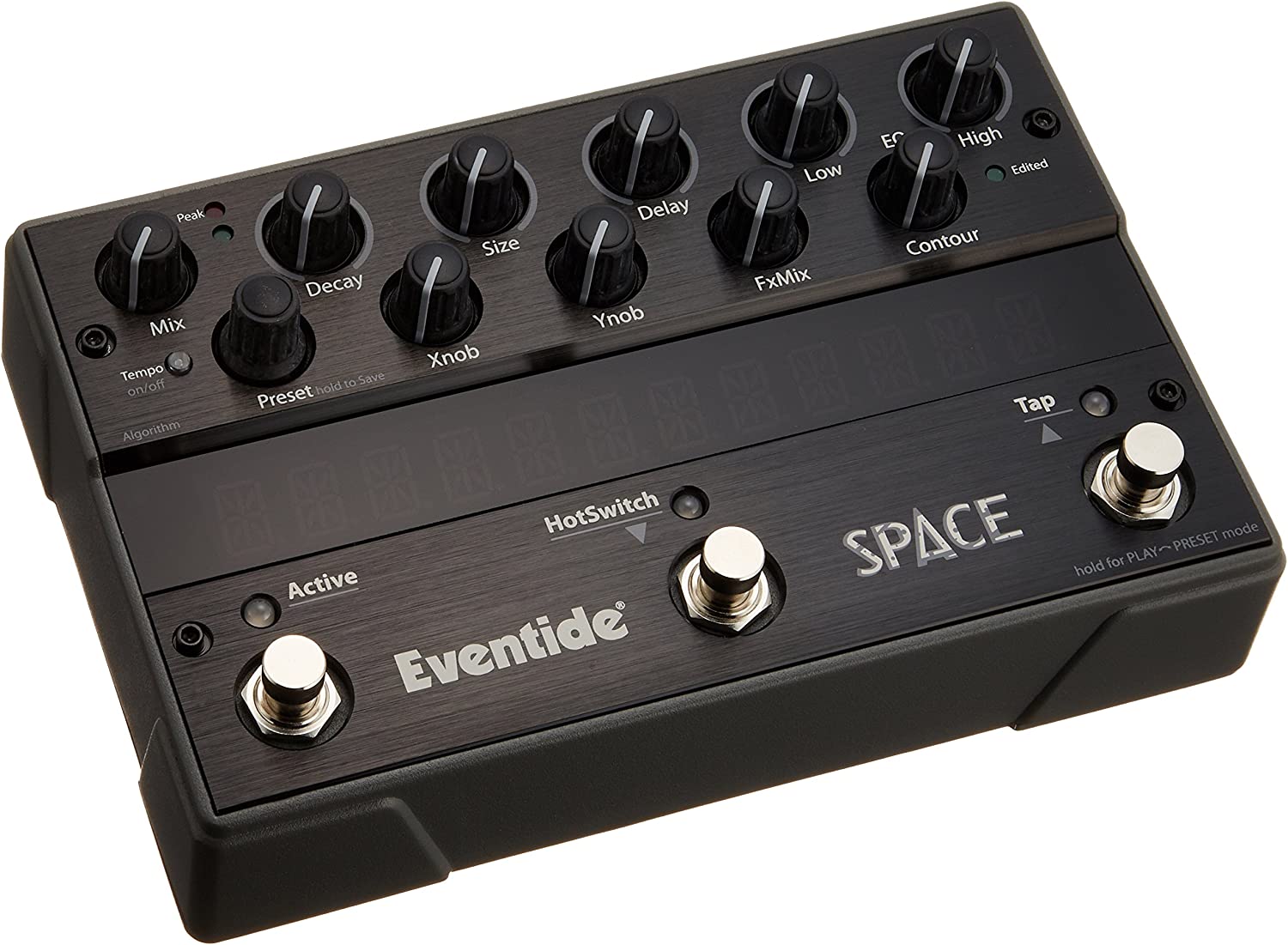
The Eventide Space Reverb Pedal is a high-quality, versatile effect unit.
This pedal comprises 12 unique, studio-grade reverb combination effects from Eventide’s renowned H8000FW and Eclipse V4 processors.
These effects include reverbs, delays, pitch shifting, tremolo, modulation, and other spatial effects, providing many sonic possibilities.
This black, right-hand-oriented pedal features a tremolo guitar bridge system for six-string guitars.
It has a true analog bypass and a USB port for software updates.
In addition, the Eventide Space Reverb Pedal has 100 presets crafted by notable artists and sound designers, making it the perfect companion for live performances and studio recordings.
Incorporating a user-friendly layout with a large display, this compact and durable unit delivers an impressive sound experience that rivals expensive rack-mount studio reverbs.
Its depth and warmth stand out, making it ideal for musicians who aren’t afraid to tweak settings and explore new sounds.
- My Review
Upon first glance, the Eventide Space Reverb Pedal immediately presented itself as a high-quality, professional-grade product.
The sleek black design and large display caught my eye and served a practical purpose: providing easy navigation while exploring its many features.
Diving into the array of available effects, I was blown away by the diverse selection.
This pedal seemed to have everything from classic reverbs to unique combinations with delays, pitch shifting, tremolo, and modulation.
It felt like having a universe of sound possibilities at my feet, a dream come true for those who love to experiment with their music.
A notable aspect of the Eventide Space Reverb is the inclusion of 100 presets handcrafted by some respected names in the industry.
This undoubtedly adds a touch of flair and inspiration to the pedal, providing interesting starting points for creating my sonic textures.
Connecting the pedal to my guitar was a breeze, and the true analog bypass ensured the signal stayed clean and clear.
The USB port for updates also came in handy, guaranteeing that my pedal would always perform at its peak.
However, I found navigating and programming the pedal somewhat challenging at times.
The learning curve was steeper than expected, and while it didn’t deter me from enjoying its capabilities, it might not be the perfect fit for those seeking a more straightforward approach.
Despite its complexity, the Eventide Space Reverb Pedal enveloped me in a world of lush and atmospheric soundscapes.
Its performance exceeded my expectations, making it a valuable addition to my gear collection.
Here are the ratings I’ll give to the Eventide Space Reverb Pedal:
Although it might not be everyone’s cup of tea, I believe those willing to explore its full potential will come to cherish it, as I have.
Its unparalleled depth and warmth set it apart, making it a must-have for the adventurous musician seeking unparalleled spatial effects.
- Pros:
- Studio-quality sound effects.
- Wide variety of spatial effects.
- 100 artist-crafted presets.
- Cons:
- Steep learning curve.
- Complex programming and navigation.
My final verdict is that the Eventide Space Reverb Pedal is an outstanding tool for musicians seeking a diverse range of high-quality spatial effects.
Its remarkable versatility, rich tone, and multitude of features make it an excellent choice for those willing to invest time in learning its complexities.
With a reputable brand behind it and its overall value, this pedal is undeniably a top pick for professionals and experimental music enthusiasts.
Boss RV-500 Reverb Pedal
Powerful and versatile reverb processor with 32-bit/96kHz processing.
The RV-500 is a powerful reverb processor with 32-bit/96kHz floating point processing, 32-bit AD/DA and unlimited programmability, allowing you to create complex reverb sounds and beyond. Featuring 12 reverb types and a host of innovative features, the RV-500 offers a journey to new dimensions of time and space.
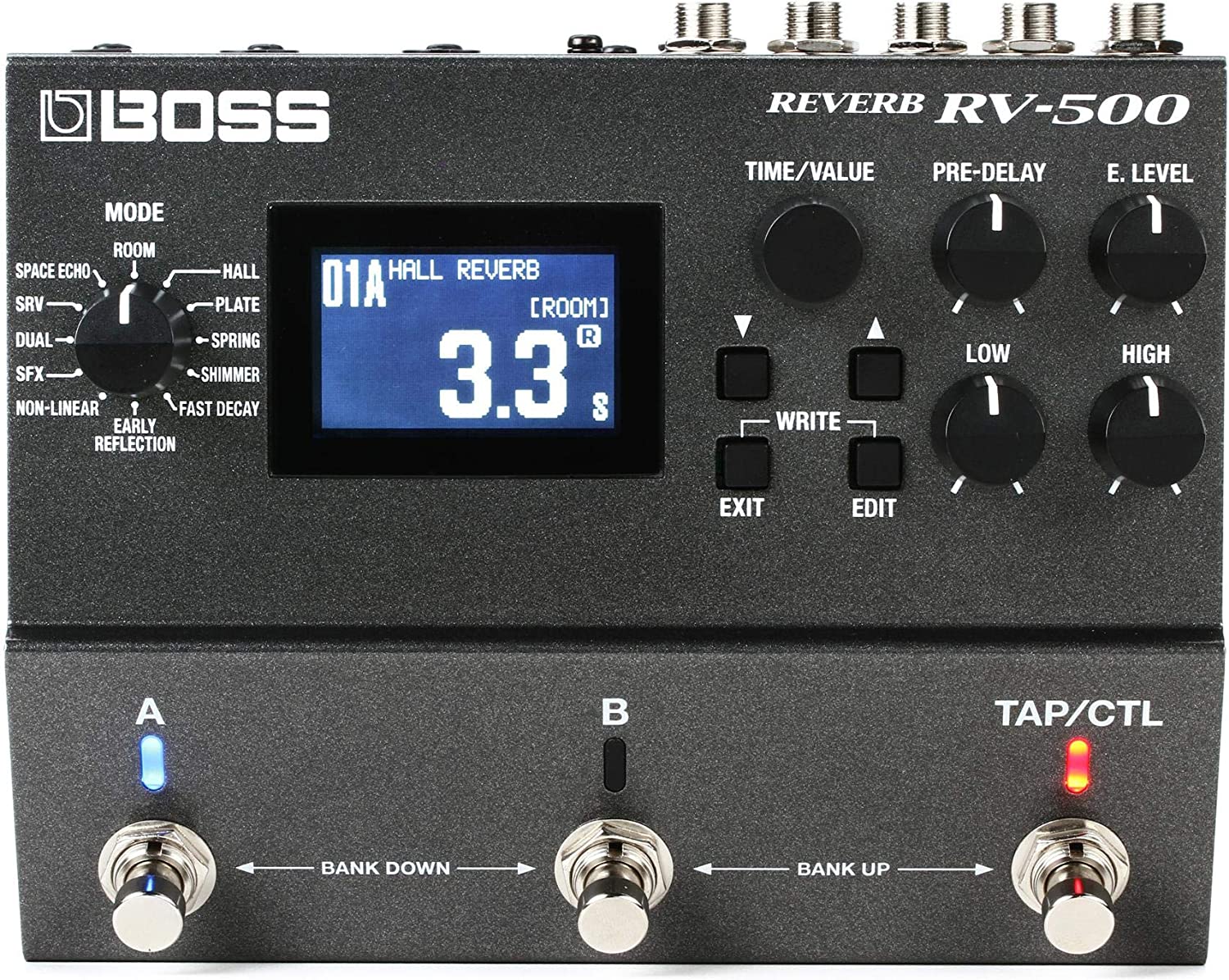
The Boss RV-500 Reverb Pedal is a top-quality, versatile reverb and multi-effects processor designed for guitarists seeking a wide range of reverb modes and customizable settings.
This compact black pedal boasts 12 reverb modes, allowing users to create everything from classic to experimental reverb sounds.
The pedal also features selectable buffered or true bypass options, allowing for tailored signal routing and preservation.
Equipped with 32-bit/96kHz processing, the RV-500 delivers outstanding sound quality, resulting in rich, immersive audio experiences.
In addition, its built-in graphic display makes it easy to navigate through the various settings.
In contrast, the pedal’s dimensions (10 x 7.85 x 4.75 inches) and weight (3.55 pounds) make it an easily transportable addition to any pedalboard.
Beyond reverb, the RV-500 offers immense programmability and studio-grade effects, solidifying its reputation as one of the market’s most powerful and adaptable reverb processors.
With this pedal, you can take your soundscapes to new levels of depth and complexity.
- My Review
I have to say, the Boss RV-500 Reverb Pedal truly blew me away with its impressive features and performance.
No wonder this little powerhouse has garnered respect among guitarists for its versatility and sound quality.
The 12 reverb modes offered allow me to explore a wide range of sonic possibilities, from classic hall and room reverbs to more experimental and other-worldly soundscapes.
One aspect of the pedal that stood out was its 32-bit/96kHz processing, which delivers incredibly rich and pristine sound.
It’s astonishing to hear how well it stacks up against other high-end reverb processors.
The selectable buffered or true bypass option is another bonus, providing flexibility in tailoring signal routing.
Navigating the RV-500’s settings is a breeze, thanks to the built-in graphic display and intuitive interface.
Although some might argue that certain presets could use some improvement right out of the box, I found that this pedal can shine in any context with a bit of tweaking.
Plus, the user-friendly software editor that Boss provides for PC and Mac adds another layer of convenience when customizing your sound.
The only major downside I experienced with the RV-500 was its lackluster spring reverb emulation, which left me feeling underwhelmed.
However, this shortcoming is easily overshadowed by the pedal’s many other outstanding features and capabilities.
Here are the ratings I’ll give to the Boss RV-500 Reverb Pedal:
In my experience with the RV-500, I couldn’t help but feel that it was a fantastic investment, especially considering the amount of control, customization, and sound quality it offers.
This pedal has become an integral part of my setup, and it’s the perfect tool for anyone looking to elevate their reverb game with a single, powerful unit.
- Pros:
- Versatile with 12 reverb modes.
- High-quality 32-bit/96kHz processing.
- User-friendly software editor.
- Cons:
- Mediocre spring reverb emulation.
- Requires tweaking for optimal results.
- Considerable learning curve.
My final verdict is that the Boss RV-500 Reverb Pedal is essential for any guitarist seeking versatility, outstanding sound quality, and comprehensive control over their reverb.
With just a bit of tweaking and exploration, this pedal can become a go-to choice for numerous musical applications.
Its powerful features, exceptional performance, and reasonable price tag make it a remarkable investment.
Electro-Harmonix Oceans 11 Reverb Pedal
Electro-Harmonix Oceans 11 Reverb Pedal for electric guitar, 9V, 5 grams, versatile reverb tones.
EMG T SYSTEM is a prewired pickup set designed for Telecaster-style guitars. It offers enhanced sound quality and hassle-free installation with its solderless connectors and pre-mounted control plate. Perfect for upgrading existing instruments. This EMG pickup set delivers vibrant, responsive sound and easy installation for Telecaster-style guitars. It features solderless connectors and a pre-mounted control plate for a hassle-free upgrade.
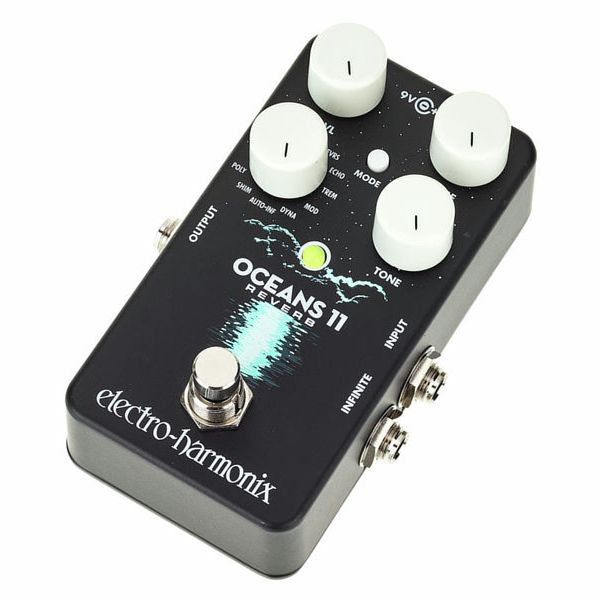
The Oceans 11 by Electro-Harmonix is a reverb pedal tailored for use with electric guitars.
Coming from the well-known Electro-Harmonix brand, this pedal offers various reverb styles, giving you the flexibility to enhance your guitar-playing experience.
The compact and solidly built pedal measures 6 x 7 x 10 inches and is lightweight, weighing only 5 grams.
It works on a voltage of 9 Volts, ensuring consistent and reliable performance.
This highly versatile pedal provides many tonal possibilities, making it a popular choice among guitarists.
With the Oceans 11, you can personalize your guitar’s sound by choosing from its many reverb effects.
The pedal is especially great for those who seek that classic, surfy drip spring reverb sound, which can be found in Fender Tonemaster and Jazzmaster setups.
- My Review
When I first laid my eyes on the Electro-Harmonix Oceans 11 Reverb Pedal, I was immediately drawn to its sleek and compact design.
Then, plugging in my electric guitar and giving it a go, I found this pedal a game-changer.
It felt like I had unlocked an entire aquatic universe of reverb, with each setting offering something unique that could take my sound to new depths.
As I explored the various reverb styles, I came to appreciate the pedal’s incredible versatility.
The classic surfy drip spring reverb stole my heart – as soon as I dialed it in, I was transported to an idealized 60s beach party, complete with bonfires and crashing waves.
However, I was also pleasantly surprised by the plate reverb, which drenched my guitar in a warm, lush wash of sound reminiscent of being submerged in a serene underwater cave.
Admittedly, some of the reverbs could be harsh, requiring extra fiddling with the controls to dial in the perfect sound.
However, I learned that patience and experimentation are key to unlocking the pedal’s full potential.
The secondary controls might take some time, but that’s nothing that can’t be mastered with a little practice.
Regarding the infinite reverb feature, I noticed a slight delay between pressing the switch and the reverb kicking in.
This didn’t bother me, but it could be annoying to some users, especially those looking to produce immersive soundscapes.
At the end of the day, the Electro-Harmonix Oceans 11 Reverb Pedal delivers a veritable treasure trove of tonal possibilities.
Here are the ratings I’ll give to the Electro-Harmonix Oceans 11 Reverb Pedal:
If you’re willing to invest time and effort into harnessing its power, you’ll be rewarded with many sonic delights that’ll elevate your guitar playing to new heights.
It’s like discovering a hidden pearl in the ocean of guitar effects pedals.
- Pros:
- Versatile reverb styles
- Compact and sleek design
- Surfy drip spring reverb
- Cons:
- Slight delay in infinite reverb
- Some reverbs can be harsh
- Secondary controls may be confusing
My final verdict is that the Electro-Harmonix Oceans 11 Reverb Pedal is a versatile and valuable addition to any guitarist’s setup, with its wide range of reverb styles and powerful tone-shaping capabilities.
Despite a few minor drawbacks, such as the slight delay in infinite reverb and some harshness in a few modes, its overall performance, user-friendly design, and the reputation of the Electro-Harmonix brand make it a worthwhile investment for those seeking to explore new sonic possibilities with their electric guitar.
Strymon BigSky Reverb Effects Pedal
Immersive, studio-quality reverb with twelve unique algorithms.
BigSky reverb pedal provides an immersive, lush experience with twelve studio-class algorithms, advanced sound engineering, and analog circuitry. It creates inspiring, musically-driven reverb sounds like Room, Hall, Plate, Spring, Swell, and more.
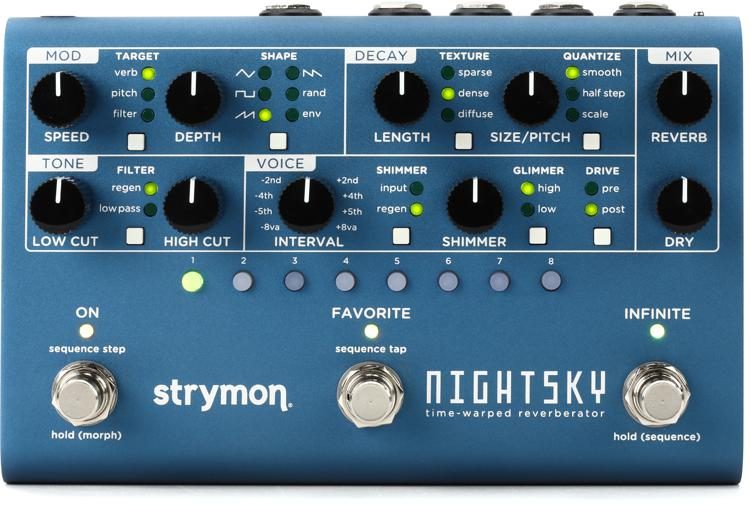
The Strymon BigSky Reverberator Effects Pedal is an innovative device that can elevate your music to new heights.
This beautifully designed pedal blends blue and black colors, making it visually appealing and functional.
In addition, it’s a compact and lightweight addition to your music setup, measuring 10 x 6 x 4 inches and weighing just 0.84 kilograms.
With the BigSky, you can access twelve studio-class reverb machines, providing a wide range of lush, inspiring, and immersive reverb experiences.
Created through meticulous sound engineering and artistic imagination, this pedal allows you to explore reverbs from the past and future.
In addition, you can experiment with various reverb effects, such as Spring, Cloud, Nonlinear, and Magneto, to achieve the perfect sound.
The BigSky also boasts an easy-to-use interface with powerful controls, making it a great addition to your pedal board.
In addition, incorporating top-quality components, analog circuitry, and a powerful SHARC processor ensures you get the best audio performance possible from this effects pedal.
- My Review
After spending quality time with the Strymon BigSky Reverberator Effects Pedal, I can confidently say this little device truly lives up to its impressive reputation.
The range of reverb possibilities is like an open playground for musicians, providing an endless array of creative possibilities.
You wouldn’t expect a compact pedal like this to house the capabilities of a full rack-mounted reverb unit, but that’s exactly what we have here.
The build quality is solid, and the stylish blue and black design adds elegance.
What sets the BigSky apart from other pedals is the selection of twelve powerful reverb machines, each offering a unique and immersive audio experience.
Diving into the depths of Spring reverbs or floating through the vast expanse of the Cloud machine, I found each effect incredibly versatile and customizable.
It’s a joy to experiment with the various settings and see what otherworldly soundscapes I could create.
The user-friendly interface, complete with easy-to-navigate controls, makes tweaking and fine-tuning the reverb effects a breeze.
In addition, I was pleasantly surprised to find the audio quality top-notch, thanks to the careful combination of innovative analog circuitry, cutting-edge SHARC processor, and high-quality components.
It’s evident that the team at Strymon put a lot of thought and care into crafting this musical powerhouse.
Here are the ratings I’ll give to the Strymon BigSky Reverb Effects Pedal:
For anyone looking to expand their sonic horizons, the BigSky Reverberator Effects Pedal is a must-have addition to their setup.
While it may take some time to master the full potential of this pedal, the learning curve is worth it, as it allows your creativity to flourish in ways you never thought possible.
- Pros:
- Twelve versatile reverb machines.
- Compact and visually appealing design.
- High-quality audio performance.
- Cons:
- Potential learning curve for beginners.
My final verdict is that the Strymon BigSky Reverberator Effects Pedal is a fantastic addition to any musician’s gear collection, offering versatility, a wide range of features, exceptional tone, and top-notch performance.
The brand is reputable, and although the value may be on the higher end for some, the quality and capabilities of this pedal make it a worthwhile investment for those seeking to elevate their sound and creativity.
What is a reverb pedal, and how does it work?
A reverb pedal is an effects pedal that simulates the reverberation or echo sound.
Reverb is created when sound waves reflect off of surfaces, creating a series of repeating echoes.
Regarding reverb pedals, they use electronic circuits to create this effect, which can enhance the natural reverberation of an instrument or create artificially reverbs for special effects.
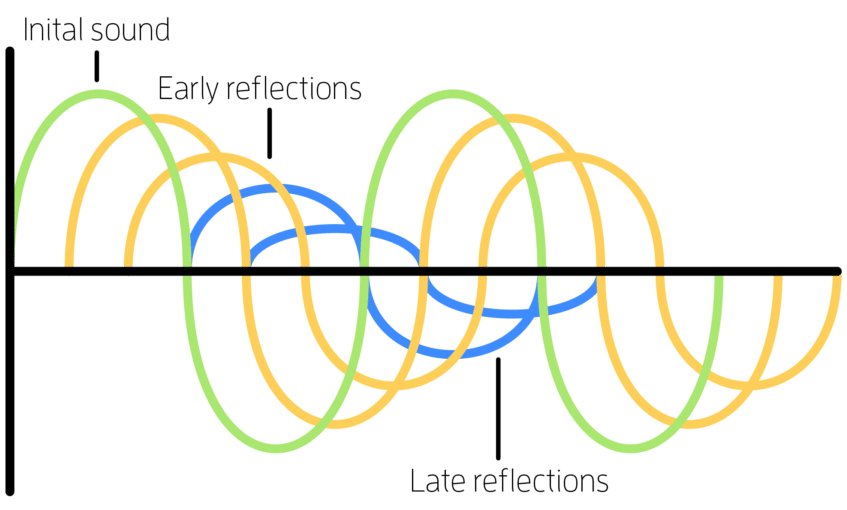
On the other hand, these pedals can be used with any electric guitar or bass and other electronic instruments such as keyboards and drums.
When used with an amplifier, they can create a wide range of sounds, from subtle ambiance to dense, wash-like textures.
Reverb pedals are commonly used in rock and blues music but can be useful in any genre where a little (or a lot) of echo is desired.
There are many different types of reverb pedals, each with its own set of features and capabilities, we’ll talk more about this below.
What to consider before buying a guitar delay pedal?
Before you buy a guitar reverb pedal, there are some things to consider; some of these things include price, quality, and versatility, among other things.
If you’re a beginner guitar player, you probably don’t need a high-end guitar reverb pedal; instead, you can choose a less-expensive model and focus on learning how to work with it and produce your sounds.
This may not be an easy task, but for that reason, here are some tips for choosing the best reverb pedal:
– Price
As obvious as it gets, price is one of the most important factors to consider when purchasing any pedal.
As a beginner, you want to find an affordable pedal that will still give you quality sound.
Many great reverb pedals under $100 will do the job just fine.
Most of the reverb pedals you’ll find out there usually cost around $50-$100.
Anything more than that, either they’re overcharging you, the extra features make it worth it, or you’re paying for a premium product, which is fine.
These numbers are relatively low price points for most people, which is good news.
You can also opt for buying a used pedal if you want to save even more money, just be sure to check the condition of the pedal and that it’s working properly before making your purchase.
– Versatility
The next thing you want to consider is versatility.
You want a pedal that can do different types of reverbs so you’re not stuck with just one sound.
Many pedals will have different modes or settings that allow you to change the sound, so be sure to look for that when purchasing.
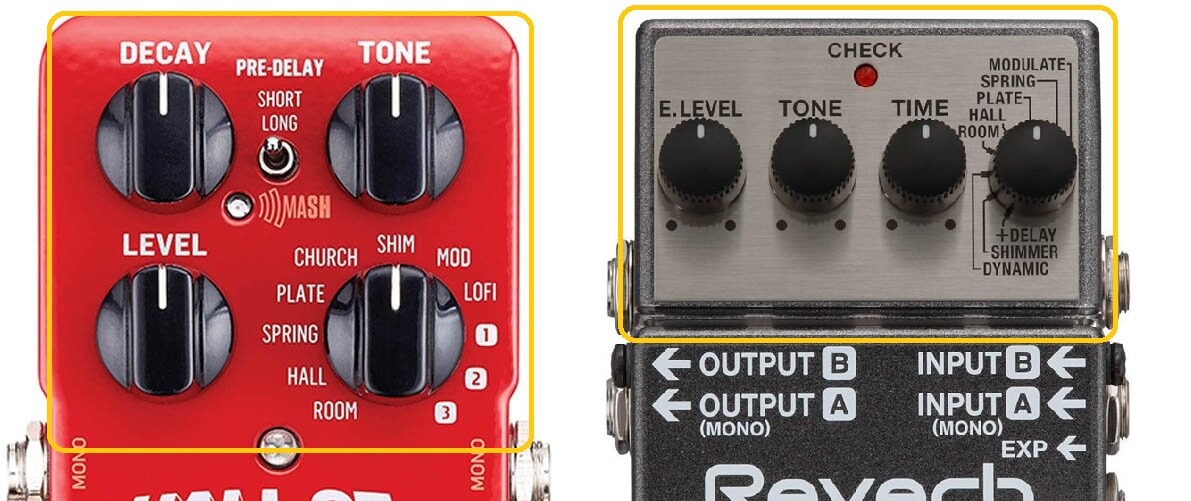
These modes and settings can be anything from changing the length of the decay to changing the reverb’s tone.
The more options you have, the better off you’ll be in the long run since you’ll be able to experiment and find new sounds you like.
– Quality
Another thing to consider is quality, when it comes to guitar pedals, you usually get what you pay for.
This goes without saying, but you want a well-made pedal that will last you a long time.
There are many ways to determine the quality of a pedal, one way is to read online reviews from other guitar players.
See what they have to say about the pedal and if they recommend it or not.
You can also find videos on YouTube of people demoing the pedal so you can hear it for yourself; other steps you can take is reading the specifications of the pedal and checking if a reputable brand makes it.
Things like the materials used, the weight of the pedal, and the warranty are all things to look for when determining quality.
Ensure that the materials used in the pedal are strong enough to withstand heavy use.
On the other side, it’s also important to find a pedal with good customer support in case of any problems.
When I talk about “quality” I mean to include the general way and structure of the buying process and overall experience, not just the pedal itself.
If a company has great customer service and is easy to work with, that’s a big plus.
As a great example, let’s take a look at JHS Pedals’ contact page:

As you can see, they list a few resources so that their users can browse their website before asking any questions, and then on top of that, they give them the option of reaching out.
They encourage others to ask questions or suggest a pedal idea or an episode of The JHS Show, which I think is very cool if they listen to customers like that.
– Size
This might not be a big deal for some people, but for others, it might be the most important thing to consider.
The size of the pedal can play a big role in how easy it is to use and transport.
If you’re always on the go, you might want to consider a smaller pedal that won’t take up too much space.
However, if size isn’t an issue for you, you can opt for a larger pedal with more features.
It all comes down to personal preference and what you feel most important.
For example, these two pedals are the Electro Harmonix Cathedral Stereo Reverb Pedal and Donner’s Reverb Guitar Pedal side by side:
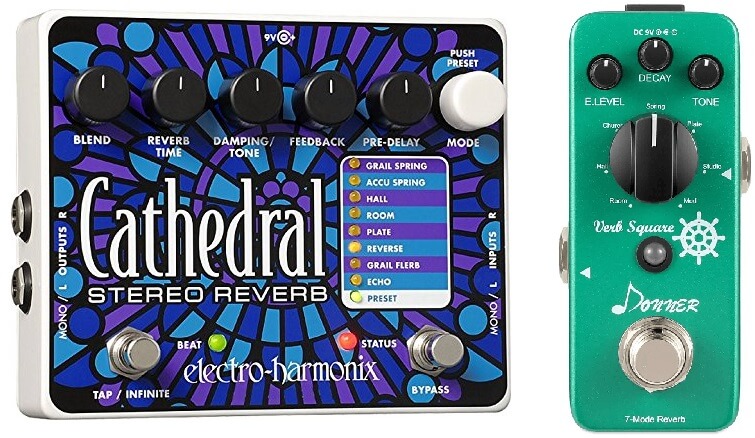
And although this image doesn’t reflect 100% of their actual size, it does help us make our point as far as width is concerned.
The one on the left will take up a lot of space in your pedalboard but will have more features available; the opposite is true for Donner’s reverb pedal.
– Presets
As far as reverb and guitar pedals are concerned, presets can be a great thing to have.
They allow you to save certain settings to quickly and easily access them anytime.
This is great if you find a sound you like and want to use again without going through all the settings to find it.
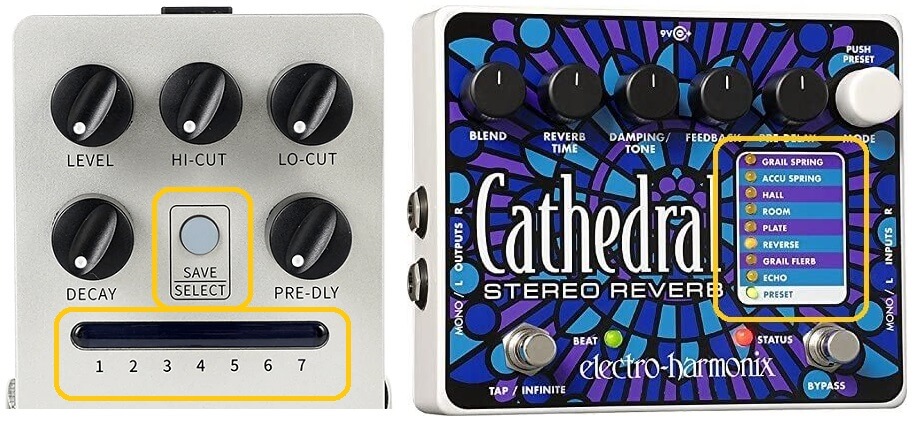
Not all pedals will have presets, but it’s something to look for, especially if you’re a beginner, but even more so if you’re a seasoned pro.
Playing live and having different songs that use different reverbs can be a pain if you adjust the settings every time.
With presets, as we mentioned, you can quickly and easily change the sound without fiddle with the settings.
We recommend:
– Extra features
Some pedals will have extra features that can be helpful, depending on what you’re looking for.
Before buying any reverb pedal, you might want to research to see if there are any extra features you might find useful.
Some examples of extra features to look for include:
- True bypass
This feature lets the signal bypass the pedal completely when turned off.
If you don’t want your signal to be affected by the pedal when it’s not in use, then this makes a lot of sense.
- Tap tempo
This feature allows you to set the tempo of the reverb by tapping a button in time with the music.
It can be helpful to make sure the reverb is in time with the rest of the music.
- Pre-delay
This feature allows you to add a delay to the reverb.
Even though it’s not a deal breaker for many guitar players, this can be helpful if you want to create a more spacious sound.
- Mix control
This feature lets you control how much of the wet signal is mixed with the dry signal.
For those of you looking to create a more subtle reverb sound, this can help you do that.
– Brand
This is another thing that some people might care about and others might not.
There are many different brands of reverb pedals on the market, and each one has its sound.
Some people might prefer one brand over another because of the sound or because they’re more familiar with that brand.
Others might not care about the brand as long as the pedal does what they want it to do.
You’d want to find a brand that’s both reputable and has been around for a while.
Some examples of reputable brands include Boss, TC Electronic, MXR, Electro-Harmonix, Donner, Behringer, JHS Pedals, and many more.

– Types of reverb
There are many different types of reverb pedals on the market today.
Some pedals offer one type of reverb, while others offer various reverbs.
It’s important to know the different types of reverbs to decide which pedal is right for you.
The most common reverb types are spring, plate, hall, room, chamber, and cathedral.
Here is a breakdown and a more in-depth look at each type:
– Spring
Spring reverbs are perhaps the most iconic and classic sounding of all the reverbs. They were first used in the 1950s and are often described as “bouncy”.
This reverb type is created by running a signal through a metal spring, giving it that distinct sound.
Even though most people can’t recognize it, they are often used in country and surf music and are known for their ability to create a “twangy” sound.
– Plate
Regarding plate reverb, it’s important to know that it’s a simulated reverb.
This means that the sound is generated using metal plates and transducers rather than actual springs.
The advantage of this is that it’s much more durable than spring reverbs, and it doesn’t require as much maintenance.
– Hall
As the name suggests, the hall reverb is meant to simulate the sound of being in a large hall.
It usually has a longer decay time and a more pronounced echo than other reverb types.
– Room
Room reverb is meant to simulate the sound of being in, you guessed it, a room.
It usually has a shorter decay time than hall reverb and doesn’t have as much echo.
– Chamber
Chamber reverb is similar to room reverb but is meant to simulate the sound of being in a smaller space, such as a bathroom or closet.
This sound is achieved by using a shorter decay time and less echo.
– Cathedral
Cathedral reverb is meant to simulate the sound of being in a large, open space, such as a cathedral.
This is achieved by using a longer decay time and more echo.
* Credits goes to prodbysab for letting us use this beautiful guitar melody as an example!
How important is having a reverb pedal?
This is a difficult question to answer because it depends on the person.
For some people, having a reverb pedal is essential, and they couldn’t imagine playing without one.
Others might not care as much about having a reverb pedal and might be just as happy with using the built-in reverbs on their amplifiers.
As we mentioned, having a reverb pedal is useful for creating a bigger sound and making your guitar sound more natural.
If you’re playing in a band, having a reverb pedal can help ensure your guitar is audible and create a more cohesive sound.
Overall, it’s up to the person whether or not they think having a reverb pedal is important, but the benefits of having one certainly outweigh the negatives.
Are all reverb pedals the same?
No, all reverb pedals are not the same!
As we mentioned before, each pedal has its own sound and many different types of reverbs to choose from.
Some pedals might have extra features that can be helpful, such as true bypass or tap tempo.
Some people may prefer one brand over another because of the sound or because they’re more familiar with that brand and the construction process they use.
Also, regarding modulations and sound control, some reverb pedals will have more options than others.
Generally, you’ll see decay, level, mix, and tone controls on most reverb pedals.
However, some might have extra options such as pre-delay or different reverbs.
Tips for using reverb in your music
Now that we’ve gone over some of the basics of reverb let’s talk about how to use it in your music.
As mentioned, reverb is a great way to create a bigger sound and make your guitar sound more natural.
Here are a few tips for using reverb in your music:
- Use it sparingly
Reverb can be a great tool, but it’s easy to overdo it.
A little bit of reverb can go a long way, so you don’t need to add too much.
- Find the right balance
When you’re mixing your music, it’s important to find the right balance between the wet and dry signal.
If you add too much reverb, it can sound muddy and overwhelming.
On the other hand, if you don’t add enough, it might not have the desired effect.
- Experiment as much as possible
Don’t be afraid to experiment with different settings and see what sounds good to you.
There is no right or wrong way to use reverb, so feel free to play around with the settings until you find something you like.
Take a look at this YouTube video by That Pedal Show titled “10 Ways To Make Reverb Pedals Work For You”:
This is a great resource for anyone looking for different ways to use their reverb pedals in their music.
They talk about different pedalboard positions, types of reverb, and also using more than one reverb pedal at once.
Do you need a reverb pedal if your amp has it built-in?
The answer to this question depends on the guitar player.
Some people might prefer to use the built-in reverb on their amplifier because it’s more convenient and they’re already familiar with the sound.
Others might prefer to use a separate pedal because they can get more control over the sound or because they want a different-sounding reverb.
Something to consider is that having a pedal is useful if you want to switch between on/off quickly or if you want to use multiple reverbs at the same time.
If you’re using the built-in reverb on your amp, then you might not have as much control over the sound since it would require you to stop playing and make adjustments on the amp.
How to order pedals on a pedalboard?
There is no one-size-fits-all approach to ordering pedals on a pedalboard, as the optimal arrangement largely depends on the specific sound you’re aiming for.
Usually, though, you will see guitar players mostly agreeing with this order:
Tuner > Filters/Dynamics > Pitch-based Effects > Overdrive/Distortion > Modulation > Time-based Effects > Looper
Aside from that, some general guidelines can help you achieve a balanced and versatile setup.
Let’s talk in detail about the order we just mentioned, but feel free to experiment and adjust to your own preferences:
- Tuner: Place your tuner pedal first to ensure your signal is in tune before passing through the other pedals.
- Filters and dynamics: Wah-wah, envelope filters, compressors, EQs, and noise gates should come next. These pedals affect your sound’s dynamic and tonal aspects, so it’s best to place them early in the chain.
- Pitch-based effects: Octavers, harmonizers, and pitch shifters should come after filters and dynamics since these pedals alter the pitch of your signal and work best with a clean, unprocessed sound.
- Overdrive and distortion: Overdrive, distortion, and fuzz pedals typically come next. They shape your guitar’s core sound, and placing them before most other effects ensures that those effects receive a strong, consistent signal.
- Modulation effects: Chorus, flanger, phaser, and tremolo pedals should be placed after overdrive and distortion effects. We do this to allow these pedals to add depth and movement to your sound without becoming overly distorted or overbearing.
- Time-based effects: Delay and reverb pedals should be placed towards the end of your signal chain. This allows them to create a sense of space and depth around the other effects, simulating the sound of a room or hall.
- Looper: If you use a looper pedal, it should be placed last in the chain. This ensures that you’re looping the entire signal, including all the effects you’ve applied.
Remember, these are just general guidelines and what generally works and sounds good.
The most important thing is to experiment and find the arrangement that best suits your personal sound and style.
For example, here’s one pedalboard signal chain that I always use:
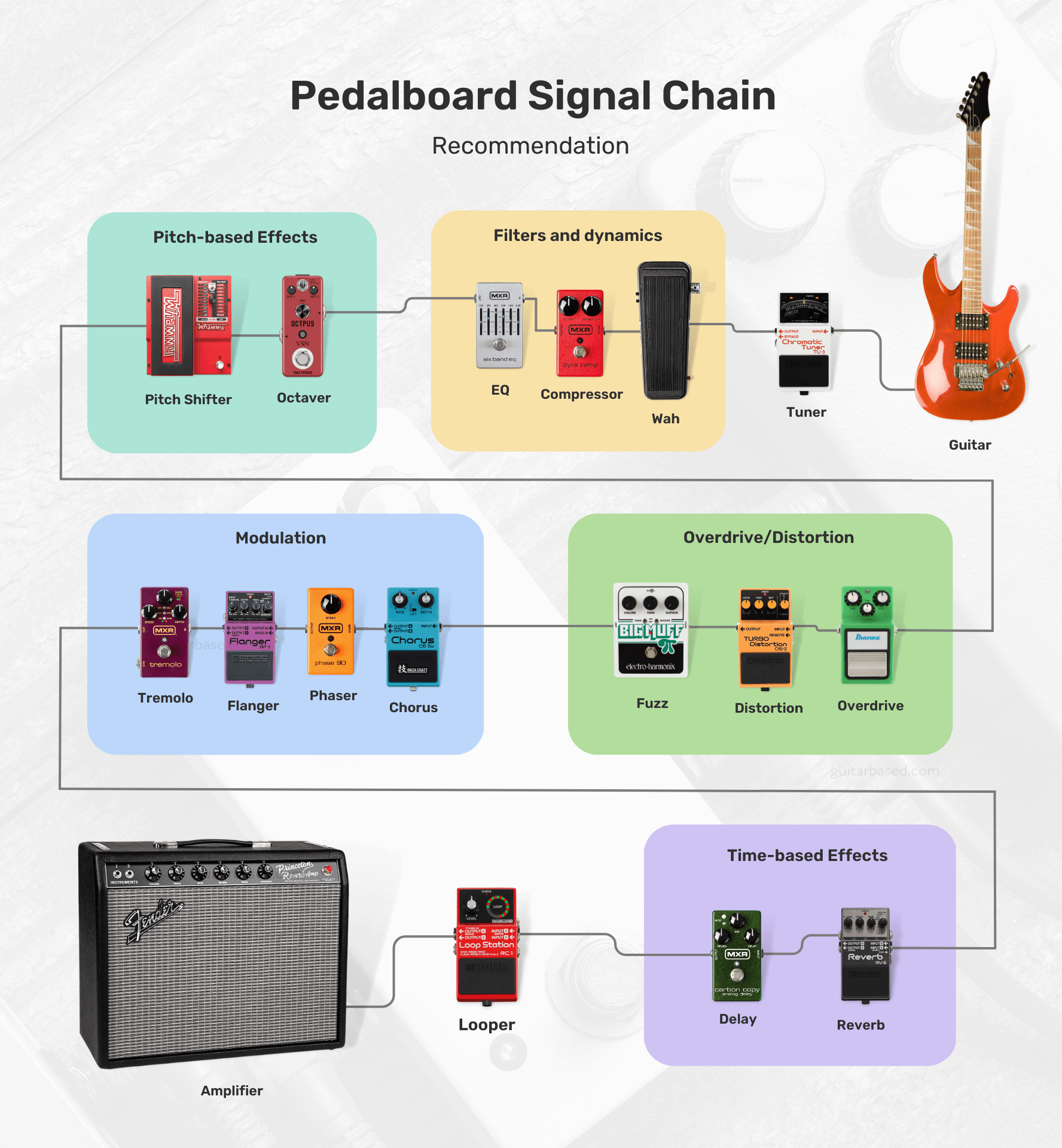
Feel free to swap the order of pedals, try different combinations, and test out unconventional setups until you find the one that works best for you.
For those interested, I’ll leave you with most of the possibilities that you’ll encounter and how to order them.
- Tuner
- Filters/Dynamics:
- Volume
- Wah
- Auto-Wah
- Compressor
- Noise Gate
- EQ (Equalizer)
- Pitch-based Effects:
- Octaver
- Harmonizer
- Pitch Shifter
- Overdrive/Distortion/Fuzz:
- Boost
- Overdrive
- Distortion
- Fuzz
- Modulation:
- Chorus
- Phaser
- Flanger
- Univibe
- Vibrato
- Tremolo
- Time-based Effects:
- Delay
- Echo
- Reverb
- Synth/Bitcrusher:
- Synth
- Bitcrusher
- Acoustic Simulator
- Multi-Effects
- Utility:
- Buffer
- A/B/Y Switcher
- MIDI Controllers
- Looper
Boutique vs. Mass-Produced pedals
Boutique pedals are generally built with higher-quality components and craftsmanship, resulting in better durability and longevity.
These pedals often feature unique and innovative designs, providing a wider range of tones and effects that may not be available in mass-produced options.
Here are a few examples of boutique pedals:

All the manufacturers also tend to have a more personal approach, with better customer service and the ability to customize pedals according to the user’s preferences.
However, boutique pedals are usually more expensive due to the smaller scale of production and the use of premium components.
Mass-produced pedals, on the other hand, are more affordable due to their larger scale of production and the use of cost-effective components.
These pedals are widely available and offer a range of popular effects, making them accessible to a larger audience.
Here are a few examples of mass-produced pedals:

The quality control for mass-produced pedals can vary depending on the brand and model, but many are reliable and offer good value for the money.
As for one of the downsides, you’ll find that mass-produced pedals may not have the same level of uniqueness or innovation as boutique options.
On the other hand, they may not provide the same level of customer service or customization options.
The choice between boutique and mass-produced pedals depends on your personal preferences, budget, and desired sound.
If you’re looking for unique tones, higher-quality components, and a more personal experience, boutique pedals may be the way to go.
But I would say, for those who are on a budget and need access to popular effects, mass-produced pedals might be a better fit.
It’s worth trying out both types to see which best suits your needs and playing style.
How much should you spend on a guitar pedal?
If I were in your position, I would first determine my budget and specific needs before deciding how much to spend on a guitar pedal.
For beginners, it might be more reasonable to start with affordable, mass-produced pedals to explore different effects without spending too much.
Guitar pedals can range in price from around $30 to over $400, depending on the brand, quality, and complexity of the effect.
As your skills and understanding of your preferred tone develop, you can gradually upgrade to higher-quality or boutique pedals.
One thing I would do is consider which effects are essential to your playing style and prioritize purchasing those first.
Allocating a larger portion of your budget to the most important pedals might be a wise choice, especially if you only need a few basic effects.
However, if you require a wide array of effects, you may want to consider more budget-friendly options or multi-effects units.
Keep in mind that higher-priced pedals often come with better build quality, unique features, and improved sound quality.
But I would also say that price is not always directly correlated with quality or suitability for your needs.
Sometimes, a more affordable pedal can deliver the exact sound you’re looking for, while a higher-priced option might not meet your expectations and are only expensive because of the brand reputation.
Can you use a guitar pedal with a bass guitar?
You can certainly use a guitar pedal with a bass guitar.
But it’s crucial to be aware that some guitar pedals may not be specifically designed to accommodate the frequency range of a bass guitar.
This could result in a less-than-ideal performance or an altered tone that might not be what you were expecting.
If you’re feeling adventurous and eager to experiment with your sound, don’t hesitate to connect your guitar pedals to your bass guitar.
This can be a fun way to explore different sonic possibilities, and you might even stumble upon some unique tones that complement your playing style perfectly.
Using a guitar pedal with a bass guitar may not always produce the desired results.
In some cases, the low-end frequencies might be lost, or the effect could sound too harsh or muddy.
To avoid these issues, you could consider looking into pedals that are specifically designed for bass guitars.
These pedals are engineered with the bass frequency range in mind, ensuring that your low-end remains intact and the effect sounds as intended.
In addition to bass-specific pedals, there are also multi-effects processors and pedals that cater to both guitar and bass players, offering a wide range of effects and tonal options.
These versatile units can be a great solution if you play both instruments and want a single device to cover your needs.
How to properly power your pedals?
When it comes to powering your pedals, you want to make sure you’re doing it right to avoid any noise issues or potential damage.
First, check each pedal’s power requirements, which you can usually find in the manual or on the pedal itself.
You’ll want to pay attention to the voltage (usually 9V, 12V, or 18V) and current (measured in milliamps or mA).
Now, you’ve got a few options for powering your pedals.
You can use individual power supplies or batteries for each pedal, but that can get messy and inconvenient.
I’d recommend going for a pedal power supply or an isolated power brick.

For example here are a few ones I recommend:
- Voodoo Lab Pedal Power 2 Plus Isolated Power Supply (My favorite)
- Rowin PW-1 Guitar Pedal Power Supply (Cheapest)
These babies can power multiple pedals at once, and the isolated outputs help prevent noise and ground loop issues.
Just make sure the power supply you choose can handle the voltage and current requirements of all your pedals.
When you’re connecting everything, use good quality power cables and keep them neat and tidy to avoid a tangled mess.
You might even want to use cable ties or cable organizers to keep everything in order.

